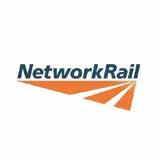




CIRAS
reporting app






reporting app


Report it in confidence, on the go.




CIRAS is the confidential safety hotline for transport. Download the CIRAS reporting app on Google Play or the App Store to raise your health, safety and wellbeing concerns. We protect your identity and share your concern with the right people, so they can act.







HS2’s benefits squandered
A new report by the National Audit Office paints a sorry picture of the handling of HS2.
Before and after the election
The new government will take a different approach than its predecessor but what does that mean for rail?


10|
Pendolino plan for HS2
David Shirres considers a plan to maximise HS2/WCML passenger capacity using lifeextended Pendolinos.



Innovations in traction
There’s no question that rail must decarbonise but plenty of debate about how, as discussed at an IMechE seminar.
West Midlands Trains’ new rolling stock and depots
New trains are joining WMT’s fleet and much work will be required to accommodate them. Malcolm Dobell reports.
Getting better each year: The 2024 Railway Challenge
Run by volunteers and IMechE staff, this year’s event was the best yet, as reflected by the scores.
Levenmouth reconnected
After 55 years, the residents of the Levenmouth area got their railway back on Sunday 2 June.
Network Rail:
Rail Innovation and Development Centres
Paul Darlington reports on a visit to the Melton Mowbray RIDC, where Network Rail tests critical infrastructure.
Sustainable FFU on Kent’s Military Canal & Blockhouse bridges
Sekisui celebrates 10 years since the installation of its synthetic wood on these two historic railway bridges.
Rail Live 2024
Matt Atkins provides a whistlestop tour of Rail Live 2024, held at Porterbrook’s Long Marston Rail Innovation Centre.
Revolutionising the global rail industry
Unipart Rail is delivering transformative innovations for construction, maintenance, and renewal projects.
Wi-Fi on trains: Why is it difficult?
Providing Wi-Fi on trains is relatively straight forward, but maintaining a stable connection to the internet is another matter.
Beaulieu Park Station
Building and operating a new station on the Great Eastern mainline will be no easy feat, says David Fenner.
Where’s my tube?
Using the underground can be a perplexing experience and getting accurate information to passengers is critical.
Twenty years of Darwin engineering
Paul Darlington looks in depth at the engineering behind the Rail Delivery Group’s customer information system.
Railways fit for the future
One certainty facing Britain’s rail network is that it must adapt to new, extreme weather patterns.
Wi-Fi HaLow
This underused Wi-Fi protocol offers lower energy consumption, higher data rates, and wider coverage than others.
Innovation in its many guises
Clive Kessell reports from RIA’s Southern Unlocking Innovation event, held in London on 12 June.


In 2018, the opportunity to electrify East West Rail (EWR) at low cost as it was built was lost when then Transport Minister declared that neither electrification nor diesel trains were needed as EWR will have “a completely new generation of low-emissions trains.” Despite commitments in the Integrated Rail and Decarbonising Transport plans to deliver an ambitious electrification programme, since March 2021 only 64 single track kilometres of electrification have been delivered in England. This was mainly for the new Elizabeth line.
Between 2013 and 2017, 7,000 new rail vehicles, equivalent to half the UK passenger train fleet were ordered. This both created a surplus of thousands of serviceable vehicles and an orders famine that now threatens UK train plants. The 2021 William Shapps report proposed the creation of Great British Railways (GBR) for which legislation has yet to be enacted. Government then committed to set out the rail network’s key strategic priorities for the next 30 years in 2022. These were never produced.
2021 also saw publication of the Integrated Rail Plan (IRP) which cancelled HS2’s leg to Leeds that had been the subject of years of planning by HS2, Network Rail, and regional authorities. In October 2023, the HS2 leg to Manchester was similarly cancelled without any consultation with relevant bodies including the National Infrastructure Commission.
As we describe, a recent National Audit Office (NAO) shows how this hasty decision will reduce passenger capacity on the already congested West Coast Main Line north of Birmingham. It thus considers that passengers may have to be priced off trains to discourage passengers from travelling on this congested route. It also shows how high-cost infrastructure will be left unused instead of being used to relieve WCML congestion. The NAO report also notes that in the nine months since HS2 was cut back, no decisions have been taken on HS2 Euston station’s scope, funding or governance. As these examples show, the previous Government’s stewardship of the rail network has wasted billions, disregarded the benefits of electrification, ignored expert opinion, and squandered an opportunity to transform connectivity between major cities.
Our article on the general election considers what might be expected of the new Government. Transport Minister, Louise Haigh has stated that her priorities are improving railway performance, rail reform, transforming infrastructure to work for the whole country and delivering greener transport. To achieve these aims, she is supported by Rail Minister Lord Peter Hendy (pictured below) who certainly has the required expertise.
As the author of the Union Connectivity Review, he highlighted how rail connectivity can grow the economy.
Labour’s manifesto promises mission-driven government supported by industrial and infrastructure strategies to kickstart economic growth. Furthermore, Hendy is working on a long-term rolling stock procurement strategy. These are promising signs of a systematic approach to ensure the best value from infrastructure and rolling stock investment.
Yet the Labour Party manifesto committed no specific sums to rail infrastructure investment given the need to first assess the economic situation. As this is much worse than first thought, large investments on rail infrastructure are a big ask. Nevertheless, the Chancellor accepts that borrowing can fund worthwhile investments. The extent to which this applies to rail enhancements, and in particular, expenditure to maximise the benefits of what is left of HS2, remains to be seen.
An urgent decision is needed to avoid a significant reduction in passenger capacity once shorter HS2 trains start running north of Birmingham. One solution to this problem, as proposed by Chris Gibb, is that HS2 services should include Pendolino trains upgraded for 155mph running. Chris also backs the construction of a New Northern Line as proposed by the Mayors of Manchester and Birmingham to relieve WCML congestion and realise the benefits of otherwise unused infrastructure, particularly at Birmingham’s Curzon Street station.
Growing the local economy was the Scottish Government’s main justification for the reopening of the 10km Levenmouth branch which adds two new stations to the rail network. A new station at Beaulieu Park, near Chelmsford, is also due to open in 2025. As David Fenner explains, constructing a new station on such a busy main line requires the provision of a central bi-directional main line.


We also feature technologies that improve passenger journeys. Of these, on-train Wi-Fi often fails to meet passenger expectations. Paul Darlington explains why providing train Wi-Fi is so difficult and what is being done to improve it. He also explains the latest Wi-Fi technology, Wi-Fi HaLow. The real-time train information system Darwin is now over 20 years old. We report how this has been developed to take account of its increasing ‘peaky’ demand. The development of passenger information systems on London Underground and LU’s Trackernet system to inform both staff and passengers is the subject of an article by Clive Kessell.
Passengers on West Midlands Trains benefit as the company increases its fleet by 110 vehicles, with 404 new vehicles being delivered and 294 older vehicles leaving the fleet. As Malcolm Dobell explains, trying to juggle the introduction of new trains and retirement of older trains whilst rebuilding most of the depots is a real challenge.
Train traction innovations were the subject of a recent IMechE seminar which considered the role and safety risks of battery and hydrogen power. As we describe, this event also considered cost effective electrification and the use of a 3kV DC supply for metros. Another worthwhile IMechE seminar
‘Adapting Railways for a Sustainable Future’ explained how railways must adapt to new extreme weather patterns if they are to continue to operate a safe and reliable service.
We also report how innovations were spotlighted at an Unlocking Innovation event organised by the Railway Industry Association. This forum put various innovations in front of potential clients and encouraged collaboration between organisations to address specific challenges, in particular those faced by the railways of London and the South East.
A tri-mode locomotive, hedgehog sleepers, quadruped robots, mobile maintenance trains, a spider excavator, and much other innovative plant were amongst the innovations on display at Rail Live 2024. As Matt Atkins reports, this impressive event brought together the very best of the industry.
Another innovation-related feature describes Network Rail’s Railway Innovation and Development Centres (RIDC) at Melton and Tuxford. These RIDC facilities, with respectively 13 and 10 miles of track, provide a safe and


DAVID SHIRRES
RAIL ENGINEER EDITOR



convenient environment to test rolling stock, on-track plant and infrastructure away from the main rail network.
The IMechE’s Railway Challenge tests locomotives on a quite different railway. As we explain, this event, now in its 12th year, gives young engineers real-life experience of design, manufacture, project management, and teamwork. To date the event has provided over a thousand young engineers with this invaluable experience. By running this event the IMechE’s Railway Division are doing them, and the rail industry, a great service.
Editor
David Shirres
editor@railengineer.co.uk
Production Editor
Matt Atkins matt@rail-media.com
Production and design Adam O’Connor adam@rail-media.com
Lauren Palin lauren@rail-media.com
Engineering writers bob.hazell@railengineer.co.uk
bob.wright@railengineer.co.uk clive.kessell@railengineer.co.uk
david.fenner@railengineer.co.uk graeme.bickerdike@railengineer.co.uk malcolm.dobell@railengineer.co.uk
mark.phillips@railengineer.co.uk paul.darlington@railengineer.co.uk peter.stanton@railengineer.co.uk stuart.marsh@railengineer.co.uk
Advertising Asif Ahmed asif@rail-media.com
Craig Smith craig@rail-media.com
Rail Engineer
Rail Media House, Samson Road, Coalville Leicestershire, LE67 3FP, UK. Switchboard: 01530 816 444 Website: www.railengineer.co.uk
Rail Engineer Videos http://rail.media/REYouTube
Editorial copy to Email: news@rail-media.com
Free controlled circulation Email: subscribe@rail-media.com
The small print
Rail Engineer is published by RailStaff Publications Limited and printed by PCP Ltd.

© All rights reserved. No part of this magazine may be reproduced in any form without the prior written permission of the copyright owners.
Part of: www.rail-media.com
A recent report by the National Audit Office (NAO), titled ‘HS2: update following the cancellation of phase 2’, has concluded that the Department for Transport (DfT) does not know how to maximise the benefits of HS2 now that phase 2 to Manchester has been cancelled. It notes that most of HS2’s original benefits were from the now-cancelled phase 2. Furthermore, HS2 Ltd estimates that once HS2 services start there will be a 17% reduction in passenger capacity.
Without HS2 phase 2, there remains a capacity issue that the DfT will have to resolve by either pricing passengers off rail or providing additional rail infrastructure which would create major disruption unless a new line was built.
The DfT is currently developing a train service specification to maximise the benefits of the current HS2 scope. This is considering options to run longer HS2 trains by lengthening platforms at Crewe or Preston where trains formed of 2 x 200-metre units could be split. The NAO report does not mention the Pendolino proposal described elsewhere in this issue.
With HS2 services expected to commence between 2029 and 2033, there is an urgent need for action to ensure that HS2 services will at least provide the same number of seats as conventional services.
After the phase 2 cancellation, the DfT had to decide how much of the ongoing HS2 work needed to be stopped or changed. The general principle is to stop work that is no longer needed unless it would cost more to stop it. It was decided to retain the current rolling stock design and fleet size as changes could lead to significant additional costs and operational issues. In some cases, the decision was to continue with committed work. For example, Birmingham Curzon Street station will be completed with seven platforms, though tracks will only be provided at three platforms. Some decisions have yet to be taken such as whether to retain passive provision for a connection to a future eastern HS2 leg.



DAVID SHIRRES
HS2 estimates that closing down phase 2 will take three years and cost up to £100 million. This includes restoring land where over a thousand boreholes have been drilled.
£429 million has been spent on land and property along the phase 2 Manchester route of which £224 million was for phase 2a between Handsacre and Crewe. As at the end of June 2024, HS2 has sold none of this land. It is estimated that disposing of this phase 2 land and property will take several years.
The HS2 cutback decision included the requirement to reset the design of HS2’s Euston station. The DfT is currently developing revised requirements for a six platform station though no decisions have been taken on its scope, funding, or governance. Although it is considered that much of the rescoped station could be funded privately, such private finance is not expected to be available for several years. Furthermore, it will take two to three years to set up a development corporation for the wider Euston quarter. The DfT has yet to set a revised date for the start of HS2 services from Euston.
The NAO report notes that the decision to proceed with tunnelling from Old Oak Common to Euston is needed this summer to avoid much higher future costs.
Up to the end of March 2024, £30.1 billion (in 2019 prices) has been spent on HS2, with £27.8 billion spent on phase 1. HS2’s estimate of final cost is £45 billion to £57 billion, though the DfT considers it should be lower than this. The report identifies reasons for HS2’s high costs which include contract incentivisation, HS2 contract management, estimates, design, and consents.
It also notes that costs have risen for reasons outside of HS2’s control, for example, inflation, Covid, Brexit, and the war in Ukraine. In addition, HS2 considers that an annual funding constraint imposed between 2023 and 2025 has increased costs by £1.9 billion to £3.1 billion.

Whatever your political views, it is undeniable that the new Labour government has a different approach to its predecessor. Here, we consider what this might mean for the nation’s railways, which were not a key factor in the election campaign.
A cash-strapped new government has far greater priorities including health, education, defence, and economic growth. Yet rail is a driver of economic growth as well as being a key part of the drive for net zero carbon transport.
The election manifestos provide an insight into the transport priorities of the different
parties, and by implication, their supporters.
The two main parties did not have transport sections in their manifestos and instead considered transport as part of their plans to grow the economy.
The Labour manifesto promised missiondriven government offering economic stability and kickstarting economic growth.
Part of this is the creation of a £7.3 billion National Wealth Fund to support growth and clean energy. There is also to be an industrial strategy council and a 10-year infrastructure strategy which includes improving rail connectivity across the
north of England. There were, however, no specific sums committed to rail investment.
As contracts expire, train operations are to be brought into public ownership, yet it is recognised that open access operators will continue to have an important role.
There were also commitments to promote rail freight and create Great British Railways (GBR) which will be responsible for investment and operational delivery.
Labour’s manifesto recognised that cars are by far most popular form of transport and so committed to maintaining and renewing road networks. It also stated that local leaders will have power to franchise local bus services and mayors will have powers to create integrated transport systems.
The Conservative manifesto essentially restated the Network North document which committed to invest the claimed £36 billion from HS2 savings on rail, buses and local roads, including £8.3 billion to fill potholes. This included upgrading the line between Newark and Nottingham as this was somehow going to halve journey times between Nottingham and Leeds. There was also an additional commitment to invest £12 billion for Northern Powerhouse Rail and to reopen Beeching lines.
The manifesto recognised the need for rail reform with the creation of GBR which is to be tasked with growing the private sector to deliver a modern innovative railway with reliable services and simpler tickets. Beyond rail, it committed to £1 billion to support hundreds of new bus routes and £4.5 billion to secure strategic manufacturing sectors. It stressed that the Conservatives were on the side of drivers, with pledges to stop road pricing and put constraints on low emission zones and 20mph traffic zones.
Agency - a public body which would help to join up the industry to put customers first, holding train companies to account, and reforming of the broken fare system.
It also required a review of the cancellation of HS2’s Manchester leg to see if it can still be delivered in a way that provides value for money, the delivery of Northern Powerhouse Rail, a 10-year rail electrification plan, and the need to work with local authorities to deliver light rail schemes. There was also a proposal to introduce a national freight strategy to move as much freight as possible from road to rail. Modal shift from air to rail was also to be achieved by banning short domestic flights where a direct rail option taking less than 2.5 hours is available and requiring airlines to show comparative air / rail carbon emissions when domestic flights are booked. The Liberal Democrats also supported maintaining the £2 cap on bus fares and wished to encourage alternatives to rural buses where they are not viable, such as ondemand services.

The Liberal Democrat’s manifesto aimed to make rail a genuinely convenient, affordable, and environmentally friendly option for both passengers and freight by establishing a new Railway
The Green party has an ‘Investing in Fairer, Greener Transport’ section in its manifesto. This does not mention rail reform and advises that elected Green MPs will push for a modern, efficient,
publicly-owned railway, with affordable fares with the required investment which should include £30 billion for rail electrification. They also require a national strategic approach to identifying lines and stations which could be re-opened.
The Greens are the only party that require a significant reduction in car use given the huge and growing contribution that private-vehicle transport makes to our carbon emissions. In respect of buses, they would push for local authority control and proper funding for bus services, to increase services in urban areas, and provide a bus service to every village.
Reform also fails to mention rail reform in its manifesto. This, however, is the only similarity with the Green manifesto as Reform would scrap all net-zero targets as these are “pushing up bills, damaging British industries like steel, and making us less secure.”
The party pledged that in its first 100 days it would save £25 billion by scrapping HS2 which it considers to be a “bloated vanity project”. During this time, it would also stop the war on drivers and accelerate transport infrastructure investment by focusing on our coastal regions, Wales, the North, and the Midlands to improve existing rail and road links.
When Kier Starmer announced his cabinet on 5 July, the day after the election, it was no surprise that the previous shadow transport secretary, Louise Haigh, had been appointed Secretary of State for Transport. However, the appointment of crossbench peer and distinguished transport professional Lord Peter Hendy as Rail Minister on the 8 July was a surprise. Former Shadow Transport Secretary Lilian Greenwood, now Minister for the Future of Roads, commented on X that “appointments don’t get better than this.” Others in the industry expressed similar comments.

In 2021, Lord Hendy led the Union Connectivity Review which highlighted the importance of the railway in delivering the economic growth needed across the nations and regions of the UK. It also recommended that WCML rail capacity between London, the Midlands, North West England, and Scotland should be increased.
8 July was also the day that Haigh addressed Department for Transport (DfT) staff to set out her five strategic priorities which she said put transport at the heart of mission-driven government. She also considered that the DfT’s motto must now be “move fast and fix things”. Her priorities were:
» Improving performance on the railways and driving forward rail reform.
» Improving bus services and growing usage across the country.
» Transforming infrastructure to work for the whole country, promoting social mobility and tackling regional inequality.
» Delivering greener transport.
» Better integrating transport networks.
Some of these priorities were reinforced in the Kings speech on 17 July. This announced that a Better Buses Bill will be presented to Parliament. It also advised that there will be legislation to improve the railways by reforming rail franchising, establishing GBR, and bringing train operators into public ownership.
The overall context for transport policy was the statement in the speech that securing economic growth will be a fundamental mission for which the Government will seek a new partnership with both business and a newly created Industrial Strategy Council. An example of this is Haigh’s visit on 24 July to Hitachi’s Newton Aycliffe plant which is soon to run out of orders. The purpose of her visit was to consider a sustainable future for the plant. In a letter to local MPs Lord Hendy advised that the government was working on a long-term strategy in a bid to “end the current boom-and-bust cycle” in train production.
In a speech immediately after the election, Chancellor Rachel Reeves advised that she wants the Treasury to be about more than
tax and spend as it has also to be a “growth department”. Though she considers that the government has inherited the worst set of financial circumstances since the World War II, she has stated that, although day-to-day expenditure must be paid for from tax receipts, the government would be prepared to borrow to invest.
The new government’s immediate priority for rail is improving performance which includes ending industrial action. Then, there is rail reform and the implementation of the policy to end private rail franchises as they become due for renewal. Finally, there is the need to consider future investment, be it infrastructure enhancements, electrification, HS2-related, and rolling stock.
Haigh has summoned poor performing train operators and associated Network Rail route directors to meetings at which she demanded action to improve performance otherwise contracts will be terminated. This included Avanti which last year cancelled 7% of its trains. Meetings were also held with trade union leaders within seven days of the election. ASLEF’s Mick Whelan considered this to be a “a major step forward and that the whole tone has changed”. He noted that he last met a government minister in January 2023.
The Passenger Railway Services (Public Ownership) Bill received its first reading in the House of Commons on 18 July. This Bill amends the 1993 Railways Act to specify that public-sector operators must provide train services except when it is not reasonably practicable to do so. Currently, the 1993 Act presumes that services will only be provided by private-sector operators unless it is not feasible.
In their “Getting Britain Moving” plan to fix Britain’s Railways, published in April, the Labour Party specified that GBR will be an arm’s length body and ‘directing mind’ of empowered rail industry experts and professionals, tasked by the Secretary of State who will set strategic direction. GBR will be responsible for planning timetables, improving services, and the operation, maintenance, and improvement of rail
infrastructure. It will also bring finances together into a single body, enabling it to take long-term decisions to increase patronage and deliver improvements for passengers and freight. Legislation to implement GBR is expected soon.
Although there is a pressing need for rail investment, the Labour Party has not specified any sum for this. Finances are constrained, however the Chancellor accepts that worthwhile investments can be funded by borrowing. She also has recently announced a review to unlock the investment potential of pension schemes. It would thus seem likely that funding will be available for schemes with a good rate of return. Moreover, Lord Hendy’s work on a long-term rolling stock strategy indicates that the new government will be taking an informed view about the future rail investment.
As highlighted by the National Audit Office’s (NAO) recent report ‘HS2: update following the cancellation of phase 2’, decisions are needed on how to maximise the benefits of what is left of HS2 and how to best resolve West Coast Main Line capacity north of Birmingham. As mentioned in our ‘Pendolino plan for HS2’ feature, these issues could be resolved by constructing a ‘New Northern Line’ along the route of HS2 phase 2a at a lower cost than HS2. The NAO report also showed that none of the land purchased for the building of HS2 phase 2a has been sold.
The new government’s approach to rail generally seems to mirror that required by the industry. For example, the Railway Industry Association’s rail manifesto calls for a long-term strategy, rail reform, and supporting the supply chain. However, Rail Partners, which represents private sector operators considers that “full nationalisation is a political not a practical solution which will increase costs over time.”
In the few weeks since the election, the new Labour transport team has certainly not been idle. Although it is too soon to judge how effective it will be, it has the required expertise, a strategy, and an understanding that rail has a vital part to play in the Government’s declared mission of growing the economy.



Under current plans, in about seven years’ time HS2 trains from Old Oak Common (OOC) will join the West Coast Main Line (WCML) at Handsacre Junction just north of Lichfield. These trains will replace most of the WCML long distance trains that currently start at London Euston as this line is now almost full to capacity. As the HS2 trains will have 100 fewer seats than the current Class 390 Pendolino trains, introducing HS2 services will reduce WCML passenger capacity north of Birmingham by 17%.
HS2 trains running between OOC and Handsacre will be 25 minutes faster than conventional trains on the WCML from London. Yet HS2 trains do not tilt and so are estimated to be 13 minutes slower than Pendolinos between Handsacre and Glasgow. As a result, with current stopping patterns, HS2 trains will only offer, at best, a 12-minute time saving between London and Glasgow which is a 4.4% saving in journey time. Manchester will get a 22-minute journey time saving as the HS2 train’s lack of tilt is less of a problem for this shorter journey.
HS2 will offer a significant increase in capacity both between London and Birmingham and between London and Rugby, as it will take traffic off this section of the WCML. It will also reduce the journey time between London and Birmingham from 81 to 45 minutes.
Hence, while HS2 will greatly benefit Birmingham, it will reduce passenger capacity on other long distance WCML services and offer minimal time savings for longer distance trains. Given the huge cost of HS2 this will, to say the least, be an embarrassment.

This situation is the result of the previous Prime Minister’s decision to cancel the HS2 line between Fradley, near Handsacre Junction, and Manchester (HS2 phase 2) without considering the consequences. For example, the first part of this line between Fradley and Crewe (HS2 phase 2a) would have significantly increased the benefits from the core HS2 route from London to Birmingham and Handsacre by relieving capacity on the WCML.
As HS2 phase 2a is routed through open countryside, this line would also have been much less expensive than the core HS2 route which required extensive tunnelling and multiple viaducts.
Parliament recognised that there is a strong case for HS2 phase 2a by passing an Act in 2021 granting powers for its construction.
HS2 stations have 400-metre station platforms to accommodate 1,000-seat HS2 trains formed of 2 x 200-metre units. With the possible exception of Crewe and Carlisle, conventional stations would require major alterations to accept 400-metre trains and so can only be served by single 200-metre HS2 trains.
With the cancellation of HS2 phase 2 there will be no station at Manchester with 400-metre platforms. Hence HS2 trains to Manchester have to be single 200-metre units with only 504 seats. The current 11-coach Pendolinos are 266-metres long with 607 seats.
The Network North document justified HS2’s curtailment by claiming that what is left of HS2 will increase WCML passenger capacity by 86% to 250,000 seats a day. This contrasts with the reality of HS2 trains having 17% fewer seats than current trains.
A further consequence of cancelling of HS2 phase 2a is that it removes the requirement for the north chord of the delta junction outside Birmingham as there is now no capacity for HS2 trains between Birmingham and Manchester. This chord is 4.4km long and consists of cuttings, embankments, and the 1.5km,
42-span, Water Orton No 1 viaduct. Although this work will be completed, Chris understands that it is now proposed that no track will be laid on this chord. Hence, without HS2 phase 2a there can no benefit from the huge expense of constructing this chord, or indeed the cost of building the large Birmingham Curzon Street station which was intended to serve HS2 trains to Manchester. Yet this botched cancellation is a reality that must be faced. This leaves the urgent question of how to make the best use of what is left of HS2 and, in particular, to ensure no loss of WCML passenger capacity north of Handsacre Junction.
and Scotland formed of two 200-metre sections for Glasgow and Edinburgh which were to split / join at Carlisle. However, the power draw and wire bounce from a 400-metre train with two pantographs would limit speed north of Handsacre to 110mph. Chris estimates that running a single 125mph tilting Pendolino between London and Glasgow would be 17 minutes faster than HS2 trains.
A recent assessment concluded that, with the current maintenance regime, Pendolinos can remain in service until 2046. One reason for this is that they have a good fatigue life as they were commissioned for

In the absence of any Government or industry plan, enter Chris Gibb an experienced railway manager whose CV includes six years as chief operating officer of Virgin West Coast Trains. On his own initiative, in discussion with his numerous senior industry contacts, Chris developed a plan to maximise HS2/WCML passenger capacity using life extended Pendolinos running at 155mph. He intends this to be an interim plan from 2030 to 2040 which allows time for decisions to be taken and executed on Northern Powerhouse Rail, HS2 extensions, Euston, the provision of longer platforms, and the development of a long-term rolling stock strategy. Using Pendolinos in this way will not only increase the passenger capacity of HS2 trains but would also reduce journey times on Scottish services. HS2 originally proposed to run two 200-metre trains between London
140mph running but are limited to a 125mph. Furthermore, their recent refurbishment showed that these trains had minimal car body corrosion.
On a special test run in 2003, a Pendolino recorded 145.5mph. Chris has been in discussions with Alstom engineers who have no doubt that Pendolinos can be fitted with new bogies and traction systems for 155mph running in non-tilt mode on HS2 lines as this technology is in reliable operation on recent Pendolino builds.
The UK’s Pendolinos were built in 2004 at Washwood Heath in Birmingham (where HS2’s train depot is now being built) with additional coaches built in Savigliano, Italy, in 2009. The Pendolino tilting train platform is widely used across Europe, in particular on Italian conventional and high-speed lines. Of the 56 Pendolino trains in service, it is the 35 x 11 coaches sets that Chris proposes should be upgraded for 155mph running.

HS2 has ordered 54 x 200-metre trains with a maximum speed of 225mph. With the lack of 400-metre platforms north of Birmingham, it might be thought a good idea to vary this order to produce fewer longer trains. Yet, this is not feasible as the Washwood Heath depot is being built to accommodate 200-metre trains. Furthermore, having 200-metre trains makes it possible to run 400-metre trains once 400-metre platforms can be provided.
Hence, this proposal does not require any variation to the HS2 train order. However, it does propose reducing their normal operational speed from the planned 206mph to 186mph to limit the speed differential with the Pendolinos to maintain capacity on the HS2 line. This would increase the journey time between OOC and Birmingham by three minutes. Chris estimates that using Pendolinos on HS2 services would leave 27 HS2 trains to be redeployed on conventional and HS2 services. This would enable the 9-car Pendolinos to be withdrawn and the displacement elsewhere of the 10 x 7-car Class 807 units that are currently being delivered.
Chris proposes that there should be 11 trains per hour (tph) on HS2 out of London of which 6 are HS2 trains and 5 are Pendolino as shown in the table.
In addition, two trains per hour from Birmingham Curzon Street to Manchester using single 200-metre HS2 trains are proposed. However, this would require completion of the delta triangle’s north chord and a “New Northern Line” as described later.

These trains would be flighted so that the leading 186mph train from London will be three minutes behind the trailing 155mph train when it reaches Birmingham’s delta junction. Chris advises that this plan would still work if it was only possible to run the Pendolinos at 140mph, although it would entail a slight increase in journey time.
There are reports that the boring of the 7.2km twin tunnels between OOC and Euston will start in 2025 as Government is now funding the £1 billion for this work. However, as both funding arrangements and the design of HS2’s Euston station have yet to be finalised, it would seem that OOC will be HS2’s interim London terminus for some years.
This is a matter of concern as, while the Elizabeth line makes OOC a more convenient destination for many travellers, a large number will prefer Euston and so may avoid HS2 trains as a result. Having a mix of HS2 and WCML services terminating at two different London stations is likely to present a confused product which may reduce passenger numbers until HS2’s Euston station becomes operational.
With OOC likely to be a terminal station for some years, it is important to maximise its capacity. On the basis of experience at other similar terminal stations, Chris considers that it should be possible to operate 11 trains per hour. However, this will require improvements to manage passenger flows and, at the station’s eastern end, a reversing siding located in the Euston tunnel connected to each platform. This siding would reduce the movements needed through the west end crossovers. Currently, there is no published track layout for the eastern end of OOC while it functions as a terminus.
The proposal to use Pendolinos would give HS2 stations a mix of rolling stock with different door positions. Hence it will no longer be possible for HS2’s stations to have platform screen doors (PSD). Chris does not consider that his proposal would affect HS2 station platform stepping distances as the Pendolino’s fold-out step is higher than the standard. However, there may be a requirement to redesign platforms and vary the train platform step configuration as HS2 platforms (and indeed all of HS2) is designed to accommodate trains built to continental GC gauge.
As a result, there will be a gap of about 350mm between coaches built to UK loading gauge and the platform edge. This may be considered unacceptable without PSD. Reducing HS2’s specified 1.655-metre platform offset to bring platforms closer to the track may be the best way of addressing this issue. However, this would rule out the future use of dedicated GC gauge HS2 trains.

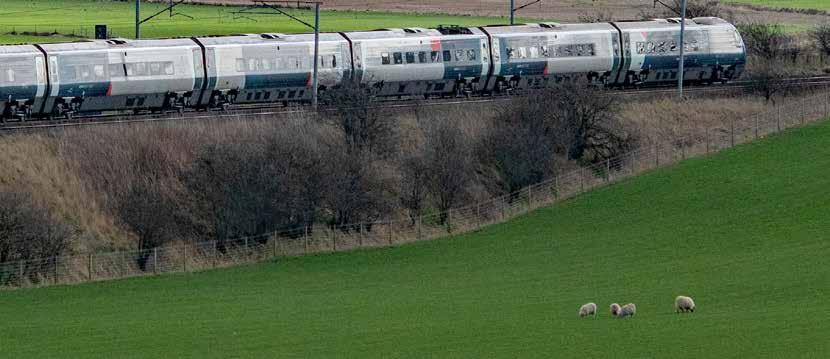
HS2’s core line was designed to carry 18 tph and be signalled with the European Train Control Signalling (ETCS) and Automatic Train Operation (ATO). The cab signalling provided by ETCS is essential as drivers cannot reliably respond to lineside signals above 125mph. It was considered that ATO was essential to achieve 18 tph as this needs each train to have exactly the same performance characteristics.
However, with the cancellation of the HS2 legs to Leeds in 2021 and to Manchester last year, the core HS2 line will now have fewer trains. Hence, Chris considers that ATO is not required. Dropping ATO would save significant costs and significantly reduce both the driver training workload and the complexity of commissioning the new HS2 line. Between Warrington and Gretna, it is planned to fit ETCS by 2030 as part of the TriLink programme for intelligent renewal and enhancement of the WCML north as described in Issue 206 (JanFeb 2024). This will allow Pendolinos to run at 140mph. If a similar enhancement / ETCS programme were to be implemented in Scotland, Chris expects that a 3 hour 40 minute London to Glasgow service stopping only at Preston and the Birmingham Interchange station would be possible. He considers that, north of Crewe, it should be possible to flight 2 x 140mph Pendolinos in a 20-minute period each hour to avoid delaying or being delayed by other trains.
As ETCS provides the driver with a continuous advice of permitted speed, it also offers a more flexible application of enhanced permissible speeds which could enable non-tilting HS2 trains to run at higher speeds.
Although London to Manchester is one of the busiest inter-city train routes, it will only be possible to run 266-metre Pendolinos to Manchester until 400-metre platforms can be provided there. Current plans are that this will be done as part of the Northern Powerhouse Rail (NPR) proposal to build a high speed line between Liverpool and Manchester via Warrington and Manchester airport which will use part of the cancelled HS2 Manchester leg. The aspiration is that the NPR high speed line will have an underground station in Manchester city centre with 400-metre platforms which would be on the scale of Stratford International. It would be expected that the NPR Manchester Airport station would also have 400-metre platforms to enable 400-metre HS2 trains to also serve the area south of Manchester.
As it will take over 10 years to provide this NPR station, there may be a case for an interim solution. One possibility is the provision of 400-metre platforms within Piccadilly station if new platforms could be provided on the north side of the station for Hadfield services.
Chris’s proposal suggests extending the NPR high speed line by building a “New Northern Line” (NNL) between Fradley and Manchester, designed for 155mph. NNL is the proposal suggested by the Mayors of Manchester and Birmingham after HS2 was curtailed. This would take HS2 services from London to Manchester, Glasgow, Liverpool and Blackpool. It would also be able to carry HS2 Birmingham to Manchester services which would take 50 minutes instead of the current 88 minutes. Once NNL is built, London to Manchester HS2 services could be extended to Leeds.
He advises that the NNL would be built using the Parliamentary powers of the High Speed Rail (West Midlands to Crewe) Act, which has not been repealed. NNL would therefore essentially follow the route of HS2 phase 2a. Chris believes that the NNL line can be built at a much lower cost than the HS2 line, although connecting it onto the conventional network at Crewe will be a significant cost. For this reason, he believes that the construction of NNL should be managed by Network Rail as it should be an integral part of the Crewe remodelling project.
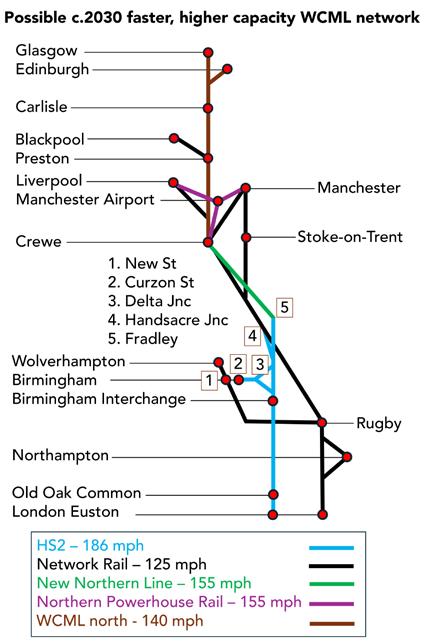

The problem that the Gibb proposal addresses is urgent. Unless a government-backed plan is agreed soon, introducing HS2 services will reduce WCML passenger capacity north of Birmingham. Although this proposal is an entirely rolling stock solution, there are infrastructure issues that need to be considered. These include beneficial infrastructure enhancements to maximise the capacity of OOC as an interim terminus, an assessment of whether 400-metre platforms could be provided at Manchester Piccadilly, and whether HS2 station platforms need to be redesigned to reduce the gap between coach and platform.
The Pendolino proposal increases passenger capacity on HS2 services north of Birmingham without the need for any infrastructure enhancements or variation to the order for HS2 trains. It also reduces the cost, time, and complexity of commissioning and traincrew training. Essentially it makes the best use of existing infrastructure, people, and the HS2 trains that have been ordered to achieve the required benefits as quickly as possible. It also is sufficiently flexible to allow for different project completion dates in the early 2030s e.g. HS2 phase 1, NNL, NPR, WCML, and ETCS.
This rolling stock solution also does not require public finance. The Pendolinos are owned by Angel Trains which could fund the enhancements and negotiate their upgrade programme with Alstom. It is also worthy of note that a major fleet overhaul is scheduled for 2026-2029 when ETCS, new bogies, and new traction systems could be installed. The


overhaul is being planned now at Angel Trains’ facilities in Widnes, Crewe, and Derby.
Chris has certainly done the industry a great service in developing this proposal. In it he advises that “I am not being paid by anyone to prepare this idea and have no vested interest in any of the organisations mentioned in it. I am an experienced WCML railway operator who wishes to see the emerging HS2 move forward in a manner that best integrates it with our rail network, for our future customers, colleagues, economy and environment.”
He also advises that he is “grateful to the many railway professionals who have encouraged and helped me develop this proposal.”
Whilst speaking to him for this feature I asked what inspired his proposal which clearly involved a lot of work. He advised that he had been speaking to a retired Polmadie driver who, in the early 1980s, drove the Advanced Passenger Train (APT) at 138mph week after week through his hometown of Carluke. After he chided Chris by saying that today’s railwaymen had wasted a golden opportunity, Chris felt he had to do something about it.
So, it seems that a retired Polmadie driver should also be thanked for this Pendolino proposal.



West Midlands Trains (WMT) is the operator of suburban services radiating from Euston as well as operating inter-urban services from Euston to Crewe and Birmingham New Street to Liverpool Lime Street under the London Northwestern Railway brand (LNR). In addition to suburban services radiating from Birmingham New Street under the West Midlands Railway brand (WMR), it also operates three branch lines: Watford Junction to St Albans Abbey; Bletchley to Bedford; and Stourbridge Junction to Stourbridge Town, the latter using the unique Parry People Movers.
WMT, formed by Abellio UK (now Transport UK), JR East, and Mitsui & Co was awarded its franchise in 2017 and runs just under 1,200 weekday services. It employs just under 3,000 staff of whom around 500 are in engineering. Its fleet of 462 EMU vehicles and 133 DMU vehicles (total 595), is increasing to 524 EMU and 181 DMU vehicles (total 705). WMT also services trains for CrossCountry, Transport for Wales and, from summer 2024, East-West Rail.
In 2017, WMT ordered 80 Class 196 DMU vehicles from Construcciones y Auxiliar de Ferrocarriles (CAF), formed into 14 four-car and 12 two-car units. It also ordered 324 Class 730 EMU vehicles from Bombardier (now Alstom) formed into 48, three-car and 36, five-car units. These trains are financed led by Corelink Rail Infrastructure, a joint venture between Infracapital and Deutsche Asset Management. The five-car units are branded LNR, and the remainder WMR.


Clearly, with 404 new cars delivered or under construction but fleet size increasing by 110 vehicles, 294 vehicles are leaving WMT. Even so, additional depot and siding space must be provided for the bigger fleet; if all these additional coaches were to be marshalled end-to-end, the resulting train would be 3.5km long, so think 3.5km of additional stabling capacity. This article describes the trains and the works to accommodate them.
Most of the Class 196 vehicles were assembled at CAF’s facility in Newport, Wales. They were launched by WMT in October 2022. A four-car set has 311 seats and two-car has 141. Seats are cantilevered from the bodysides and all units have the usual accessible toilet, three bike spaces, at-seat power, and USB sockets. Four-car sets also have a second more compact toilet. In concept they are similar to Class 197 units described in Rail Engineer 197 (July/Aug 2022).
Since entering service there have been some technical challenges for which fixes have been made or are under way, including:
» Software functionality, affecting many systems such as passenger information.
» Build quality snags e.g. wiring, relay issues/ security, auto reversing gear.
» On board hot box detection faults.
» Cab to saloon door faults.
» Leaking window seals.
» Yaw damper brackets (see Rail Engineer 195 (March/April 2022).

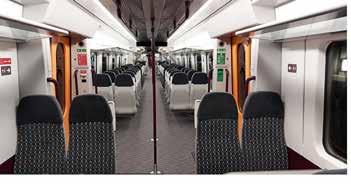
This fleet has two sub-classes, all built at Alstom’s (formerly Bombardier’s) factory in Derby. The 730/0 three-car units are 90mph EMUs and each car is 24 metres long. They were first introduced on London EustonTring/Bletchley stopping services in mid-2023 allowing elderly Class 319 units to be withdrawn, but are really intended for West Midlands suburban services. They have 199 cantilevered seats in a 2+2 and 1+1 seat layout to promote space around doorways and space for 344 standees giving a total of 546 - 149 more people than can be accommodated on a Class 323. There are three bike spaces and a universal toilet.
The five-car Class 730/2 has 463 cantilevered seats in 2+2 layout (with armrests between the seats unlike Class 730/0) with plenty of table seats, two standard toilets, and one universal toilet. These trains are configured for 110mph operation (the differences in top speed for the two subclasses is the result of different dear ratios). The 24-metre-long coaches provide a10-car train that is the same length as a current 12-car Class 350 train. Both sub-classes are the first Aventra models with though gangways between units. Some of the issues that have arisen
include software/train control and monitoring faults which seem to have affected all the Aventra trains. Unlike earlier Aventra trains, the Class 730 has sliding plug cab doors and these are prone not to close on canted track. There have also been issues with the cab door droplight design. Additionally, problems have been found with the Automatic Selective Door Opening system, master Input/ output unit analogue to digital converter, passenger information screens, water ingress, and battery chargers. The trains’ three phase drives include large capacitors and an explosive failure in the line converter module of a Class 345 Elizabeth line Aventra led to a variety of risk management activities that delayed testing. Finally, these are the first Aventra trains intended for 110mph operation and ride quality is still being tuned.


Rail Engineer has frequently described the complexity of putting new trains into service. They are part of a complex integrated system with many interfaces, and, on some parts of the network, it might be the first change in 30 years requiring people to change duties and/ or learn new skills. Right now, the commercial conditions for the railway are not what they were before the pandemic, leading to even more commercial pressures for all parties. This is an expensive transition in a money constrained industry. The new fleets sometimes require a different approach to operation and maintenance, and everyone in the train operating company is affected in some way.

That said, there is a great opportunity for customer improvements, marketing, and growth. But, back to risk, stakeholders expect performance improvement even during fleet transition despite experience to the contrary.
Some examples of the real-world issues include:
» Traincrew consultation, agreement and training, linked to trains being built for Driver Only Operation, then converted for guard operated doors.
» Signal sighting with through gangways/longer trains, some relocation of signals needed. For example, at Lichfield Trent Valley high level, there is a signal at each end of the station. The combination of slightly longer trains and the gangway meant that one signal had to be relocated.
» Car stop marker boards, stopping positions and Platform Train Interface risk assessments, e.g., location of wheelchair spaces has changed and every platform requires assessment to ensure the access ramp can be accommodated at the new train’s stopping location.
» Cyber security vulnerability risk.
» Train to wayside systems, data access compatibility, links to shore systems.
» Automatic Selective Door Opening system interface (160-Metre-long trains already require selective door opening at some stations on the Euston-Crewe service, more doors will be locked out on 10-car new train services).

The long running national disputes with railway trade unions led to some issues with local engagement which were overcome, but it was still challenging to get the staff trained and on to rostered operation before their training ‘expired’ requiring refreshers. There was also a huge commercial workload. Each new fleet involves the train manufacturer, the financier (e.g. ROSCO), and WMT, often with DfT involvement too, in activities such as revised delivery schedules and financial settlements of one sort or another. As mentioned, the Class 730 fleet size was changed from 36 to 48, three-car units and from 45, five-car (with first and standard class and two standard class layouts) to 36, five-car with one standard class only layout.
Delays to the new trains mainly arising from Covid meant that other negotiations to extend leases for the trains being replaced were required.
Class 170 DMUs and Class 323 EMUs are being cascaded from WMR. Class 319 EMUs have been, and Class 350/2 will be, returned to their ROSCO. Finally, all this has to be reflected in support contracts and WMT’s National Rail Contracts.
Depot works were delayed and interim solutions to maintain the new trains were required. These delays have resulted in increasing cost due to construction inflation forcing additional reviews including scope reduction and re-pricing, but work is now underway at all depots to accommodate more trains and their maintenance requirements. Another complication is that the LNR Class 730s will not be maintained at Siemens’ Northampton depot.
Earlier, it was stated that the increased fleet would need more stabling space. Of course, during transition when new vehicles have arrived but cannot yet be used, pressure is even greater. Unless something changes, this risks depot gridlock and/or poor safety practices. All this means that there is a major programme of depot construction and upgrades. What follows is a site-bysite summary of the works.
Tyseley depot to the south of Birmingham is a large DMU depot and stabling location where changes are being made to accommodate longer


units, such as track remodelling and extensions to maintenance sheds. In addition, mobile gantries with hoists, side pits, and facilities for synchronised lift are being provided. Accompanying all this are improvements to arrangements for refuelling, cleaning, waste oil removal, electrical shore supplies, replenishing controlled emission toilets (CET), and filling sand hoppers. An automatic vehicle inspection system is being provided at one end of the stabling sidings.
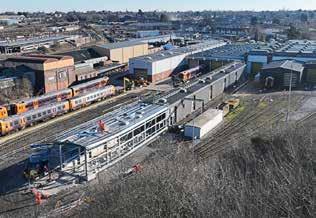

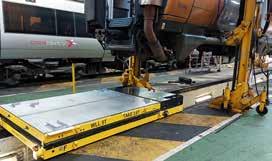


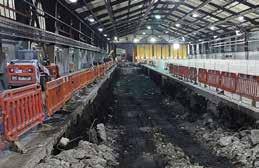

At Worcester a new four-car fuel/adblue/CET point has been built together with three new sidings for four-car trains. Despite being adjacent to Worcester Shrub Hill station, these are known as the Hereford Sidings.
Soho EMU depot to the west of Birmingham has received a new mobile access gantry and hoist system to access roof mounted equipment such as air conditioners not fitted on the current Class 323 units. There will also be changes in the sidings to walkways and provision for servicing CETs will be provided.
A major expansion of Bletchley depot is under way so that it can be the main base of the LNR Aventra fleet. The depot building will be extended and internally modified to accommodate a five-car synchronised lift, gantries with a hoist for access to air conditioners, and more suitable pits. Additional stabling sidings will be provided alongside the depot building. Complicating all this is that the three two-car Marston Vale DMUs also have to be maintained/serviced at Bletchley whilst the works continue. The depot is located approximately at right angles to east of the West Coast main line. This is a major investment which is being financed by Porterbrook Leasing. The stabling sidings parallel to the main line will also receive attention.
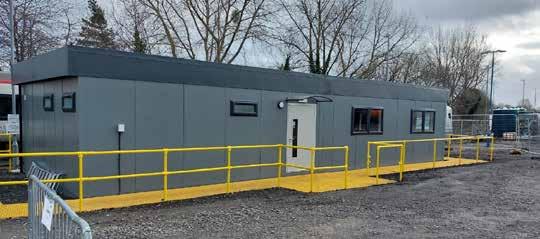
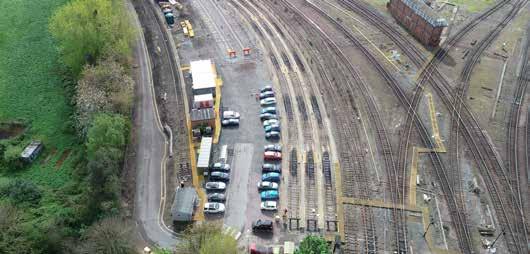
Further works are being carried out at Shrewsbury, Coventry, North Yard, Camden depot, and, subject to planning permission, a new light maintenance/servicing facility will be constructed at Bescot.
As is probably clear, ‘just’ buying some new trains has resulted in massive change to WMT. Whatever the programme was pre-Covid, trying to juggle introducing new trains and retiring older trains whilst rebuilding most of the depots must have affected the work of everyone in the organisation, and there’s probably another two years work before it is all finished. Rail Engineer wishes them all well.
This article is based on a presentation given to the Milton Keynes Centre of the IMechE Railway Division by John Doughty, WMT’s engineering director.





Improve the efficiency of your workshop with our range of prefabricated steel maintenance and inspection pits, built to UKCA and CE certified standards.
Premier Rail Pits offer the following benefits:
• Guaranteed water tight
• Up to 70% quicker installation time compared to precast concrete
• High quality finish
• All internal service ducts fitted prior to installation
• Any length available
• Rail attachments fitted prior to installation
• Full or part installations are offered
A full range of accessories and safety products is also available.




Tel: +44 (0)1775 821222
Email: info@premierpits.com
Web: www.premierpits.com/railpits





At last year’s Railway Challenge, the chief judge, Bill Reeve announced that without doubt it had been the best challenge yet. This year he said the same thing, and the scores showed that this was no mere repetition. Indeed, this year’s challenge was the first in which all the locomotives present were operational and set out to complete the circuit. Unfortunately, however, one was unable to complete it.
This event is run by volunteers and staff from the Railway Division of the Institution of Mechanical Engineers (IMechE). Their contribution is much more than the challenge weekend as it requires many hours developing the competition, judging paperbased challenges beforehand, and supporting the teams. For example, a virtual team networking day was run in December to introduce the challenge, offer technical advice, and describe common pitfalls and good practice.
The competition takes place over three days on the Stapleford Miniature Railway on the Gretton Family estate near Melton Mowbray, operated by the Friends of the Stapleford Miniature Railway (FSMR). This 10 ¼ inch gauge, 1/5th scale railway which is 3km long, has a balloon loop and a station with sidings that have hard standing for the competing locomotives. The main track challenges are done on Sunday which is also the spectator day.

Although the FSMR is not normally open to the public, it has occasional open weekends such as that on 24 to 26 August for which details are available on links here.

For the winning team from the University of Sheffield, it was certainly their best challenge yet. Of the 12 challenges to date, Sheffield had competed in nine of them, taking fourth place on three occasions and coming second in 2021.
While most teams have a university or business leader, the Sheffield entry is managed by the student-led Railway Challenge at Sheffield (RCAS) club. This has about 30 undergraduate students from all years across multiple engineering disciplines. As a result, its final-year students have significant experience of the challenge.
As regular readers may recall, Rail Engineer has reported on the Railway Challenge since the first event in 2012. Our feature in Issue 203 (Jul-Aug 2023) has a detailed description of the locomotive specification, the on-track and paper-based challenges, how the locomotives are deemed fit to run, and the challenges are assessed. This feature focuses on the 2024 results and what was new for this year’s challenge.



Alstom/University
challenges
The challenges in the first 2012 event were ride comfort, traction power, and energy recovery (distance moved using stored energy). In addition, the teams were judged on their design philosophy and business case presentation.
In 2014, noise and reliability challenges were introduced where teams points were deducted for any failures or significant late running. A maintainability challenge which timed the removal and replacement of a powered wheelset was introduced in 2015.
2019 saw the introduction of three new challenges: an auto stop challenge which required the locomotive to stop at a precise location automatically; an innovation report; and the production of a technical poster.
This year saw the removal of the noise challenge as almost all teams had battery locomotives, hence the noise measured was largely that of the FSMR’s coaches they hauled. It also saw the introduction of a further four new challenges. However, these were optional and teams were invited to enter one or more. Only a team’s best optional challenge score was included in the overall result. These were:
» Autocoupler challenge to design, implement, and demonstrate an automatic coupler system.
» Aerodynamic challenge to simulate the locomotive running at high speed to demonstrate its aerodynamic performance.
» Location Announcement challenge to design an audio-visual announcement/ display system that announces key locations around railway.
» Remote Data Recording and Monitoring challenge to transmit locomotive performance data to a central location.



A new option for the 2023 challenge was an entry level competition for teams aspiring to enter a working locomotive. This required teams to undertake the presentation challenges of producing a technical poster, design and innovation reports, and a business case presentation. They were also required to use Computer Aided Design (CAD) to demonstrate that a key feature of their locomotive design is fit for purpose.



As well as not having to enter the track-based challenges, the rule that no more that 40% of a team can have previously participated in a Railway Challenge does not apply to the entry level teams. Although there were no entry level teams in 2023, three such teams entered the Railway Challenge this year.
As can be seen from the 2012 to 2024 results table, almost all the teams entering a locomotive were regular entrants. These were the Universities of Aachen (7), Birmingham (8), Huddersfield (10), Sheffield (9), as well as Transport for London (9) and a joint Alstom/ University of Derby team (8). In addition, the University of Warwick and Newcastle University respectively entered the challenge for their fourth and second years.
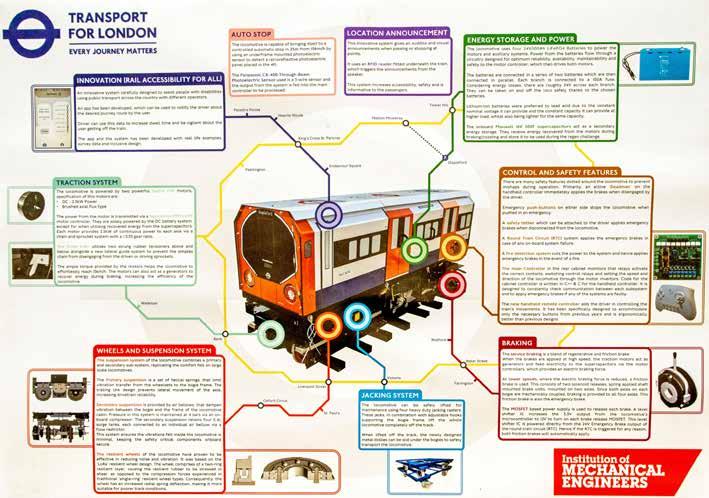


While regular entrants often re-enter the same locomotive, this is usually modified to address lessons learnt from the previous challenge. In addition, new challenges and amended competition rules require teams to alter their locomotives.
This year, for the first time, there were three entry-level teams. These were from Herriot-Watt University, Siemens Mobility, and, from India, the Institute of Technology (IIT) Kharagpur in West Bengal. All aspire to enter a locomotive next year, though for IIT Kharagpur this is a particular challenge as freight costs will be about the same as the cost of their locomotive.

One of the challenges for the organising committee is attracting more entrants. However, although the Stapleford Miniature Railway is ideal for the Railway Challenge, its layout needs to be enhanced to realise this vision. To date, the maximum number of entries has been 11 locomotives on site which is about the maximum number that the railway can accommodate. To accommodate an increased number, two constraints need to be addressed. These are the lack of space around the station to work on locomotives and the need to increase the number of locomotives that can undertake challenges on the railway’s loop.
To provide more space at the station, a siding from the present headshunt to a new turntable has been constructed. This will eventually have provision for 20 track spurs. These will have hardstanding with several able to accommodate two locomotives and


so will provide sufficient space for 24 teams to work on their locomotives with the flexibility to change the order of despatch if required.
Professor Simon Iwnicki, who proposed the Railway Challenge in 2010 and has chaired the organising group ever since, explained that this work has been generously supported by Network Rail which surveyed the site and provided an initial layout for the turntable, as well as donating ballast. The FSMR has also actively supported this project for which various volunteer weekends have been organised which have included Railway Challenge teams and Railway Division young members.
Currently, two locomotives an hour can undertake the track challenges on the railways 1.2km loop. As a result, the maximum number of locomotives that can be tested during the Sunday track challenge day is 12. As the balloon loop provides an out and back layout from the station, the number of locomotives that can be tested is limited to two trains an hour. To increase the railway’s capacity and flexibility, it is proposed to provide a holding loop close to the balloon loop together with a chord that could provide a continuous circuit. One issue with this proposal is that a river bridge may have to be rebuilt as one of the chord’s turnouts would have to be placed on it.


With 15 challenges to evaluate for the 10 locomotives and three entry level teams, the judges themselves had a challenging task especially as the award ceremony started immediately after the last on-track challenge run.
The award ceremony was hosted by chief judge, Bill Reeve who advised that the judges considered that this Railway Challenge has seen the most impressive set of entries in all the years of the competition. He was also impressed by the teamwork shown at the event and stressed that this really matters as railways only work well when all the operators help each other. The judges felt that the teams from the Universities of Warwick and Sheffield had done a great deal to help their fellow teams and so had awarded them additional discretionary points.
Prizes were first awarded to the entry level teams. Siemens Mobility Limited were the overall winners and Herriot-Watt University won the CAD challenge. Bill particularly wished to thank the IIT Kharagpur team members who, coming from India, were the longest-travelled entrant ever.
With so many challenges it took some time to present all the prizes. These were as follows:
» University of Sheffield – Auto stop; Reliability (joint first); Innovation; Autocoupler; Location announcement and Remote data recording.
» University of Derby / Alstom – Ride Comfort; Energy storage; Traction; Reliability (joint first).
» Pozan University of Technology – Maintainability; Aerodynamic.
» Transport for London – Design; Business Case; Technical poster.
With the University of Sheffield team having won six of the challenges, it was perhaps no surprise when Bill announced that they were the overall winners of the Railway Challenge. He noted that this was the team’s ninth year at the challenge and during this time they had learned much. He considered them to be worthy winners as from their arrival on site they had impressed the judges with the consistent quality and intelligence of all aspects of their design, presentation and operation. As a result, Sheffield scored 1,724 points out of a possible 2,000.
In second and third place were respectively the University of Derby / Alstom and Poznan University of Technology. Bill noted that the top three teams had very creditable and very impressive results.
Advance notice has been given that next year it is proposed that there will be:
» An energy efficiency challenge.
» The option for drivers to ride on their locomotives.
» An increased number of carriages hauled, from two to three.
» Locomotives that are fully bi-directional for both operation and coupling.
In this way the IMechE’s Railway Division is continuing to develop this successful competition which to date has seen 89 teams experience the Railway Challenge. While this concerns small scale locomotives, what the teams face are real world challenges of project and supplier management, producing a workable design then building, testing, and running it. Working as an effective team which, as one sponsor noted “doesn’t want to murder each other by the end of the event”, could also be considered quite an achievement.
By providing over 1,000 young engineers with this experience in a risk-free supportive environment, the IMechE’s Railway Division has provided an invaluable service to the industry. Indeed, Bill Reeve advised that past participants, who are increasingly filling quite senior roles within the railway industry, say that the Railway Challenge experience was the highlight of their training.
When reporting on the Railway Challenge, it is always a pleasure to experience the buzz at Stapleford and see the effort and enthusiasm displayed by the teams. It is also impressive to see how the FSMR, Railway Division volunteers, and IMechE staff ensure the success of this event and its smooth running. The contribution of the event sponsors whose financial contribution made the event possible must also be noted. These were: AtkinsRealis; Angel Trains; CAF; RSSB; and Network Rail.
Output at full power: up to 240 hours without additional sunlight
Maximum visibility: approx. 900 m (depending on the course of the road)




temperature range: -20 °C to 85 °C
one-side and two-side reflectors and different colours possible
STRAIL (UK) Ltd. | Tannery Lane // Send / Woking // GU23 7EF // Great Britain Head Office +44 (14 83) 22 20 90 // info@strail.com






















Sunday 2 June was a good day for residents of the Levenmouth area as, after 55 years, they got their railway back. The first public train services between Leven and Edinburgh were celebrated by a street fair and funfair on the promenade. The day before, a special train ran from Levenmouth to Edinburgh and back for Golden Ticket holders who were members of the community with a close connection to the railway, including members of the Levenmouth Rail Campaign (LMRC).


The railway was officially opened on Wednesday 29 May when 300 invited guests were welcomed at Edinburgh Waverley station by Network Rail Scotland managing director Liam Sumpter. Following this, a specially branded train took guests to ceremonies at the lines’ two new stations, Leven and Cameron Bridge, where the guests of honour were Scottish First Minister John Swinney; Scottish transport secretary, Fiona Hyslop; Fife Council leader, David Ross; ScotRail managing director Joanne Macguire.
In his speech, First Minister Sweeney emphasised how the new railway would provide economic, educational and social opportunities and attract inward investment. He also paid tribute to the tenacious members of the LMRC for their successful campaign. LMRC Chair Dr Allen Armstrong was proud that the disadvantaged Levenmouth area had been able to mount an intensive community-led
campaign which was supported by the council and had cross-party support in the Scottish Parliament. He also thanked rail experts from the Scottish Retired Railway Officers Association (Scotland) who had an important role in advising the campaign and helping it to present its case in a coherent manner.
Although this opening ceremony had been planned for some time, having politicians making speeches at such a high-profile event could have been considered a breach of the pre-election purdah period, hence this opening ceremony had to be approved by the Cabinet Office. It was for this reason that Network Rail issued no press releases about the Levenmouth re-opening.
The Leven service opened with an hourly frequency of trains to Edinburgh via Kirkaldy due to a shortage of diesel multiple units (DMU). The provision of a half hourly service would require an additional six DMUs which are not likely to be available until 2025 from, for example, the completion of the East Kilbride electrification. Once these units become available a half-hourly service will be introduced with one train running between Leven and Edinburgh via Dunfermline to create additional journey opportunities.

The re-opening of the 10km Levenmouth line was the fifth Scottish rail re-opening in the last 20 years. Previous re-openings were the Larkhall branch (5km) in 2005; Stirling to Alloa (21km) in 2008; Airdrie to Bathgate (22km) in 2010; and the Borders Railway (49km) in 2015. In contrast to previous projects, the Levenmouth branch was never formally closed although it last carried freight traffic 20 years ago. Hence the line was still owned by Network Rail and parliamentary powers were not required to reopen it. Construction of earthworks to current standards did however require the purchase of some parcels of land.
PHOTO: DAVID SHIRRES

In August 2019, the Scottish Government announced the go-ahead for design work to support the reopening of the branch. A further announcement in January 2022 confirmed that £117 million was to be invested in the Levenmouth railway and that it will open in spring 2024.
The 9.7km-long Levenmouth branch has few straight sections as it follows the Rivers Ore and Leven for almost all its length, so its line speed is generally 45mph. It has no major earthworks although it has some steep slopes which required regrading or reprofiling. River protection work was also required. The branch’s five river bridges were generally in good condition but needed grit-blasting to bare metal, recoating with a special paint system, and the installation of new timber decks.
The railway was built as a double track railway but had single track when it closed to passenger services. To ensure timetable resilience, the reopened railway is double track except for a 1.5km single line section from Thornton North Junction where it joins the main line.
As part of the Scottish Government’s plan to decarbonise its railway, the Levenmouth branch will eventually be electrified. To minimise the disruption and cost of the branch’s future electrification, mast foundations were installed as part of the reopening project. As this was done in accordance with a detailed electrification design, there will be no infrastructure clashes or signal sighting issues when the line is electrified.
The line has two new stations at Cameron Bridge and Leven. Cameron Bridge is 3km from Leven and has two 196-metre platforms and a 125-space car park. As it is situated on the main road to Fife’s East Neuk it could be a well-used railhead. Hence there is space for a further 300 cars. The terminating station at Leven is a single seven-metre-wide island platform. Its two platforms are 205-metres long. The station has a pavilion with customer facilities and a welfare facility for ScotRail staff. It has a 134-space car park and is adjacent to the town’s bus station.
Work to re-open the Levenmouth branch started with devegetation work late in 2020 followed by site investigation work in 2021. Work started to remove the old disused track and other redundant infrastructure in July 2022. Track laying was done in stages and was completed in August 2023.
The reopening project was managed by Network Rail with the main suppliers being: AmcoGiffen, Atkins, BAM, Siemens, SPL Powerlines, Story, QTS, and Rail Systems Alliance Scotland (RSAS).

Whilst the line was mothballed, it was crossed by various paths. For understandable reasons, Network Rail did not wish to create level crossings on the line. Hence, various paths across the line had to be closed where the significant cost of a footbridge could not be justified. At the thinly-populated area at the start of the branch, there was some protest at the closure of a path which was neither a right of way nor an adopted Fife Core path. Hence the cost of a footbridge could not be justified. However, three new substantial footbridges are to be provided in the populated area between Cameron Bridge and Leven to maintain existing active travel routes and provide new routes to railway stations. These are being provided by the Levenmouth Connectivity Project which is funded by the Scottish Government’s Places for Everyone programme, as well as funds that Fife Council received from the UK Government’s Levelling Up Fund. Although these bridges were not part of the reopening project, Network Rail worked

closely with this connectivity project to minimise its cost and submitted planning applications for the three footbridges. With low land by the River Leven and disused coal mines in the area, these planning applications required flood and mining risk assessments.
Around 8,000 people live within 2km of the Cameron Bridge. This includes the settlement of Methilhill which is 200 metres from the station, though separated from it by the River Leven. It is to be connected to the station by a 140-metre-long active travel bridge over the river with one 70-metre and 2 x 21-metres spans. As the steelwork fabricator recently went into administration it was not possible to complete this bridge in time for the re-opening. It is hoped that it will be completed by the end of the year. In the meantime, residents face a longer walk using existing footpaths.
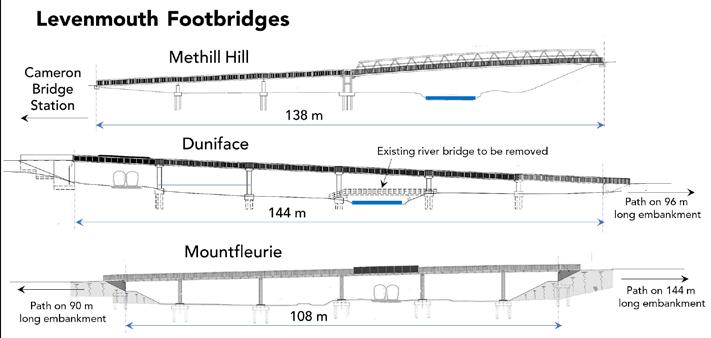
A Fife core path crosses the railway at Duniface, 600 metres east of Cameron Bridge. Here a 144-metre active travel bridge with 6 x 24-metre spans was craned into position in May. The bridge was not quite complete at the time of the opening. Another previously well used core path used to cross the railway at Mountfleurie, 1.3km from Leven. In October, Fife Council announced that it was to provide a 108-metre active travel footbridge of 2x14-metre and 4x20-metre spans over the railway and Fife Heritage Railway at an expected cost of £5.8 million. Unfortunately, land issues have delayed the construction of this bridge which is not expected to open until 2025. In the meantime, local residents using this path to commute to work face an additional 40-minute walk per day.
The LMRC branded its campaign as “more than just a railway” as it believed that a re-opened railway would be the catalyst to regenerate the largest settlement in Scotland without a railway. Many of the 46,000 people in its catchment area have a quite low standard of living with the closure of mines, docks, and other industries. A Scottish index of multiple deprivation (SIMD) report showed that 44% of the Levenmouth population were in the bottom 20% of the SIMD ranking.
When, in August 2019, Michael Matheson, the Scottish Cabinet Secretary for Transport, Infrastructure and Connectivity, announced that the case had been made for the Levenmouth rail link, he said that “giving Leven a direct rail link to the capital, will lead to an enhanced local economy, bringing better access to employment and education and the potential for new investment.”
The LMRC’s argument that a new railway would regenerate the area had thus been accepted by the Scottish Government.
Although Leven is only 37 miles from Edinburgh by road, this journey takes almost two hours by bus which denies residents without cars access to jobs and education in the city. This is no longer the case as, by train, the journey time is 71 mins. The train’s journey time to the nearby town of Kirkcaldy is 18 minutes which is 10 minutes quicker than by bus. The new railway thus offers transformational opportunities especially as new local bus services have been introduced to connect with the railway.
The new rail service is also likely to be well used by those from Fife’s East Neuk. With actual journeys from the Borders railway terminus at Tweedbank being over seven times the predicted number, this showed that drivers will travel
further to a railhead than previously thought. Other Scottish railway re-openings have also generated significantly more traffic than expected, as well as attracting significant investment.
In 2022, the former managing director of Scotland’s Railway, Alex Hynes addressed the LMRC’s 100th meeting. He noted that, at a recent presentation, the project team didn’t mention rail, sleepers, or ballast. Instead, they emphasised how this project will improve the life chances of people in Levenmouth by creating economic growth, improving health and wellbeing as well as social cohesion. He also stressed that Network Rail hasn’t been given over £100 million of Scottish taxpayers’ money for this project because they like railways. It’s because they like what railways do. With the focus on growing the economy after the general election, it is to be hoped that the new government understands how improved railway connectivity between population centres will generate economic activity as it certainly will do for Levenmouth.
Rail Engineer has reported on the Levenmouth re-opening project in Issue 197 (Jul-Aug 2022), Issue 200 (Jan-Feb 2023) and Issue 205 (Nov-Dec 2023) and would like to thank Network Rail’s Joe Mulvenna, Kirsty Ryder, and Owen Campbell for their help with these features.


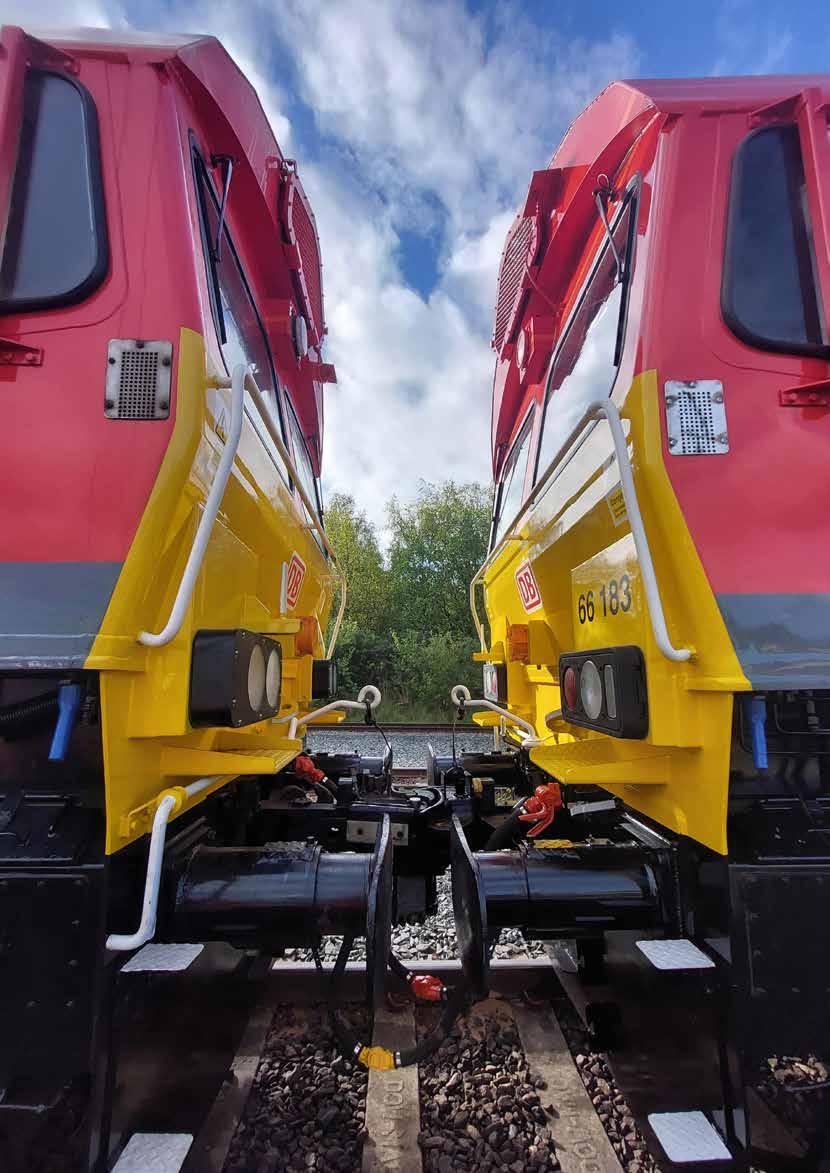


Earlier this year the Midland and North Western section of the IRSE visited the Network Rail Innovation & Development Centre (RIDC) at Melton Mowbray in Leicestershire for a technical tour. There are two Network Rail RIDCs, one in Melton Mowbray and the other in Tuxford in Nottinghamshire.
The two RIDCs’ test facilities are run by the same team, which is part of Route Services within Network Rail. RIDC principal engineer Carl Saunders gave a presentation covering both RIDCs and arranged a tour of the Melton site.
Testing of railway infrastructure, as with all complex systems, has always been important and today it is arguably more important than ever. The rail network is a ‘system of systems’, which must interface and work together seamlessly. Many assets are connected by data links, controlled by complex software routines which may contain many ‘bugs’ and require real time testing to identify and resolve. Electro Magnetic Interference / Radio-Frequency Interference (EMI/RFI) is a growing problem -primarily due to there being far more processor-controlled devices, high-frequency circuits, and low-power transmitters which generate unwanted electrical signals. These unwanted signals can have harmful effects on equipment, reducing performance and even causing equipment to fail. Testing can help to identify issues and provide mitigations, such as screening or filters.
The two RIDC test facilities provide a safe environment where new and modified rolling stock, plant, on-track machines, infrastructure, equipment, and technology can be tested without causing problems on the main rail network. The testing at the centres is carried out either by Network Rail or another company in the rail industry. The facilities are also available for training.
RIDC Melton and RIDC Tuxford both closely represent the operational railway and include many characteristics found across the national network. Ironically, when the visit took place the northern part of the RIDC Melton test facility was cut off due to an earthworks failure, so the facility is very representative of the operational railway!

RIDC Melton was formally the British Rail Old Dalby 13.5 miles test track which ran between Melton Mowbray, Leicestershire, and Edwalton, on the course of the Midland Railway’s route between Kettering and Nottingham. This route closed to passengers in 1967 and to freight in 1968, and was first used as a test track in May 1966. Over the years, it has been involved in numerous projects. This included developing the BR Advanced Passenger Train (APT-E) project in the 1970s and, 40 years ago in July 1984, a destructive fullscale integrity test of a nuclear flask train was undertaken.
In 2014, the Department for Transport passed the facility to Network Rail, and it has since been developed into the RIDC to support both high- and low-speed testing of vehicles and infrastructure, including 25kV AC overhead line and 3rd/4th rail DC equipment. Two separate test tracks are available. A high-speed line between Melton Junction and Edwalton, incorporating 13 miles of track up to 125mph (11 miles with overhead line equipment) and a slowspeed test track from Old Dalby to Stanton Tunnel, with four miles of track up to 60mph. There is also a large depot facility at Asfordby with four 200-metrelong workshop roads. One is fully pitted and one with comprehensive lifting and jacking equipment.

Mechanical assets also need real time operation to ‘bed in’ and demonstrate the required reliability. Railway vehicles can typically have a design life of 30 to 40 years, but the systems within the vehicles (particularly electronic equipment) may have a far shorter life, and a train vehicle is likely to require several equipment upgrades throughout its life. Any new or modified asset will need testing on a real railway, but the busy rail network cannot afford to have untried infrastructure causing failures and delays, which is where the RIDCs can help.

During the mid-1990s, as a result of British Rail’s privatisation, Old Dalby was leased out to various companies, including Serco, Alstom, and Metronet (which maintained LUL) to conduct various testing. Alstom electrified the former Down line using 25 kV AC overhead line equipment to support the testing and development of the Virgin Class 390 Pendolino trains, which were later operated on the West Coast Main Line. In 2007, the test facility was leased to Metronet to test and commission London Underground S Stock trains which were being manufactured by Bombardier in Derby.
There is a 415V shore facility available, together with stabling and dedicated office and welfare facilities for up to 40 people. This provides the opportunity and ability to safely change any infrastructure characteristic to support testing, all on site at the RIDC without having to move vehicles and infrastructure back to their home depot or factory.
The capabilities of RIDC Melton include the testing of European Train Control System (ETCS), Technical Specification for Interoperability (TSI) high-speed noise compliance, over cant deficiency, EMC, brake performance, Wheel Slide Protection (WSP), single/dual pantographs, coupling compatibility, rescue and recovery, surge pressure in tunnels, low adhesion, and any new technology trials and demonstrators. The IRSE visit itself generated discussions on how some signalling and telecoms assets could be tested at Melton.




The test facility at Melton is available Monday to Friday 07:00 to 19:00, and Saturday 08:00 to 18:00. GB Railfreight (GBRf) operates the site for Network Rail, which includes leading an operations meeting each Friday at 10:00 to determine the following weeks running, depot works, and train arrivals, together with managing any infrastructure and facility faults. A robust process is in place for OHLE energisations. Train test track movements are controlled by the line control signaller, who ensures trains are returned to the depot and the OHLE is de-energised before the test track is handed over to the infrastructure maintainer.
Community environmental and engagement activities include supporting and maintaining local community connections. The activities include lunches, volunteering activities, collections, school safety talks, wildlife gardening, birdboxes, recycling, and Christmas trees.
The RIDC System Review Panel carries out the assessment of any change entering the RIDC railway system, with the objective of
RIDC Tuxford is 15 miles north of Newark, in Nottinghamshire, off the Robin Hood line between Thoresby Junction and High Marnham. The centre has been in Network Rail ownership since May 2009 and consists of 10 miles of single-line test track with a 2.8mile double section capable of testing up to 75mph. Testing is available 24/7. There is a short section of non-live 25kV type catenary and a short section of nonlive 3rd/4th rail (so diesel or battery power trains only). As well as providing a safe operating environment for testing, RIDC Tuxford is also used by the rail industry to deliver training and competency assessments. The centre provides office and mess facilities, sidings, stabling, a non-pitted 30m x 10m shed, dummy overhead line and 3rd/4th rail equipment, with the ability to change infrastructure characteristics. Road Rail Access Points (RRAP) are available and the testing includes for adhesion up to 1:25 W6A vehicle gauge, handbrake / slip brake performance, and drainage. RIDC Tuxford also offers a bespoke capability for RIS-1530-PLT Issue 6 – “Rail Industry Standard for Technical Requirements for On-Track Plant and their Associated Equipment and Trolleys” testing, which is unique in Britain. Training areas are also available for tamper, stone blower, thimbling, and lifting.


The RIDCs are a key part of enabling new and modified technology within the rail industry by providing a safe and reliable testing environment, where engineering innovation and development can take place without causing problems on the operational network. Both RIDC Melton and RIDC Tuxford are located in the middle of Britain with good rail access, and they are essential for dynamically testing rolling stock, on-track plant and machines, infrastructure, and equipment. Modern railway systems, such as ETCS, can be very complex and have a fairly short life compared to legacy equipment, but they must provide excellent availability and reliability in order for rail transport to be sustainable. This can only be achieved by undertaking safe dynamic validation testing at facilities such as RIDC Melton and RIDC Tuxford.

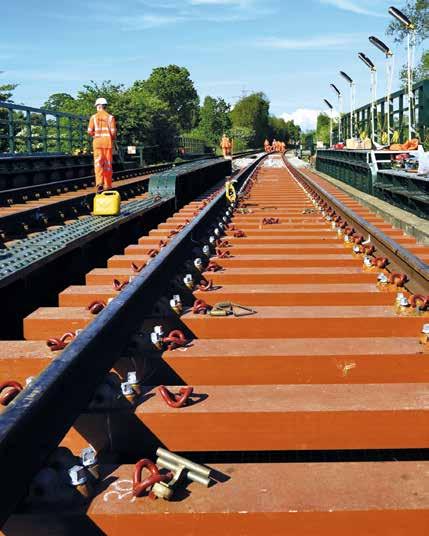








Sekisui celebrates 10 years since the first installation of its synthetic wood on network rail and over 44 years of use worldwide.
Since 1980, Sekisui has engineered and manufactured synthetic wooden sleepers made from Fibre-reinforced Foamed Urethane (FFU). In 2014, Network Rail engineers installed the first FFU baulks and cross-sleepers as replacements for traditional hardwood on Military Canal & Blockhouse Bridges in Kent. Since then, FFU has been used to provide track support on more than 65 railway bridges in the UK & Ireland.
The FFU product was first introduced on Japanese Railways in 1980 and early installations are still performing to specification. FFU is now widely used on railway infrastructure in 33 countries globally to support track on bridges, decking for level crossings, plain line sleepers, and Switch and Crossing (S&C) bearers.
Recently, Sekisui was invited back to site in Kent to meet with Network Rail’s Track Maintenance Engineers (TMEs) Greg Harrison and Paul Furnival. The pair were responsible for fitting out the two railway bridges on the Ashford to Hastings line, with longitudinal baulks and cross-sleepers manufactured from FFU.

Sekisui learned that the Military Canal was built between 1805-1809 as a defensive structure designed to protect against possible invasion by Napoleon’s Army. Such an attack never happened, but the canal still acts as an essential form of irrigation and provides drainage to much of the surrounding marshland. The bridges over these waterways provided a great location for the first Network Rail installation of FFU.
During September 2014, the TMEs completed the FFU installations at Military Canal Bridge 1800A (ELR: ATH 62miles72 chains) & Blockhouse Bridge 1800B (ELR: ATH 62miles 75 chains). The bridges are of an open steel-framed construction, and both have twin tracks. The Military Canal bridge has a length of 29.5 metres and Block House bridge has a length of 13 metres. In total, six pairs of FFU longitudinal baulks, measuring 410mm x 370mm x 7.45 metres, were used to replace the life expired timber waybeams. The FFU product was manufactured in Japan to the required tolerances for precise installation. The cross-sleepers were then positioned on top of the longitudinal baulks and milled to achieve predefined track geometry prior to refitting the baseplates and rails.
Sekisui was honoured to be invited back to site to gain some feedback from a customer’s perspective some 10 years after Network Rail replaced the timber with the synthetic product. Paul said that people were very sceptical about the options
when he first mentioned the need to find an alternative to wood, but he felt repeatedly renewing in hardwood every 15 to 20 years was a thankless task. FFU was recommended by Network Rail’s head of track and at that time a trial site was needed. Greg and Paul were in the right place at the right time.
Greg and Paul told us they were proud to accept the challenge of installing this cutting-edge material and to have this project on their portfolios. There was a lot of learning and concerns to be addressed prior to the install, because this was the first of a kind in the UK. Now they both reflect positively on the decision for Network Rail’s Kent track maintenance team to become the trailblazers for FFU in the UK. Following their success, the FFU product has subsequently been installed on many more bridges on Network Rail infrastructure.
After this successful trial, Sekisui was issued with full Network Rail Product Acceptance Certification PA05/06576 for the installation of FFU to support track systems over bridges, including run on and run off sleepers, bearers for guard rails, and gathering rail panels. Sekisui welcomes the opportunity to work with designers to provide solutions for each individual bridge asset. The FFU baulks can be fabricated & milled to meet structure specific geometry requirements, including providing holes, notches, pockets, and variable cross level to individual baulks.
The key benefits over hardwood include: longevity with over 50 years’ service life; FFU is form retentive, not prone to splitting or absorption of water; and it also does not rot, or deteriorate in sunlight, and therefore contributes significantly to asset ‘whole life cycle cost reduction’ by reducing maintenance and renewal interventions. The product does not require maintenance inspectors to complete micro-drilling during service life and is fully recyclable.
Paul and Greg told us that the track over the bridges had been maintenance free for the last 10 years, other than for lifting and packing the run on and run off sleepers into the ballasted track. As the photos show, the FFU product has not deteriorated in form and other than some minor fading of the paint.
Greg said: “the material still looks almost as good as new, contrary to how timber looks after 10 years of service when splitting and rotting is often evident”.
The TMEs believed the use of FFU offered Network Rail reduced whole life cost and, by reducing interventions, renewal would not need to be considered for at least 50 years. There was also a view that the annual frequency of inspection of the longitudinal system could be doubled due to the improved reliability of the assets.
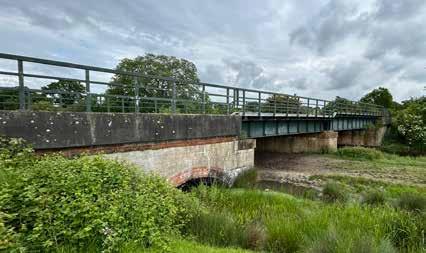

Based on their experience with FFU on bridges, the TMEs are keen to install FFU level crossing surfaces on their numerous farm and foot crossings. In addition, they are keen to install FFU sleepers and S&C bearers in the future. When hardwood is phased out by Network Rail the engineers think using FFU would naturally become their synthetic choice.
Sekisui would like to thank Greg Harrison (TME Ashford) and Paul Furnival (TME Tonbridge) for choosing FFU in 2014, facilitating the recent site visit, and contributing to this article.
Developed in conjunction with Japanese National Railways, FFU synthetic sleepers are made using a pultrusion process. Continuous glass fibres are soaked and mixed with polyurethane and then hardened at a raised temperature, moulded, pulled, and cut to length. This creates a high-quality material that has the life expectancy of plastic and the weight of natural wood, which can be worked like natural wood.
First installed in Japan in 1980 and adopted for standard sleepers since 1985, FFU has subsequently been installed on numerous projects in Europe over the past 20 years, particularly turnouts and bridges. Up to the end of 2023, there was more than 1,950km of track with FFU sleepers around the world.
Tests of the original 1980 sleepers undertaken by the Railway Technical Research Institute in 2011 predicted that the FFU sleepers could safely continue in use for another 20 years, giving a total life of at least 50 years. FFU sleepers have also been certified by Germany’s Federal Railway Office for use on tracks operating at up to 230km/h and 22.5t axle load.




Rail Live, the UK’s largest outdoor rail event, returned to Porterbrook’s Long Marston Rail Innovation Centre (LMRIC) on 19-20 June. With 280 exhibitors in attendance, the two-day exhibition saw over 7,000 visitors gather to marvel at the most up-to-date rolling stock and equipment and hear the latest from industry experts at the event’s many panels and presentations.


MATT ATKINS
This is the tenth year that Rail Live has been held at the LMRIC which Porterbrook permanently acquired in March this year but operated since 2021. In that time, the firm has overseen the site’s transformation, upgrading and enhancing facilities across the centre. It recently announced plans to renew and electrify the centre’s 3.5km track and, once this is complete, the development will take the company’s total investment in the site to over £75 million.
Rail Live is a huge occasion, the vast space of the LMRIC packed full of plant, equipment, and vehicles of all shape and sizes. Unfortunately, your writer had but one day (19 June) to take in as much as possible but could easily have covered the remainder of the exhibition and still missed much that it had to offer.
Known for its wide array of rolling stock on display, 2024 did not disappoint, with an assortment of locomotives including GB Railfreight’s 66309 (above far right) “Charley Wallace”, a Class 66 which returned to service in May, as well as a number of South Western Class 701 Arterios, which went into service in January.
A key attraction this year was a Class 93 tri-mode locomotive (right), courtesy of Rail Operations Group and Stadler. Constructed in Spain, the Class 93 can run off the 25kV AC overhead system, rated at 5,360hp. It also has a 12-cylinder Caterpillar C32 diesel engine, rated at 1,205hp, and two LTO (lithium titanium- oxide) batteries.
The locomotive on display, 93001, undertook its first main line solo run on 28 May, from Worksop to Sheffield and back, and saw further testing throughout July on the West Coast Main Line between Crewe and Carlisle. Once the results of the testing are analysed, locomotives 93002-010, which are all constructed and waiting to go, will be shipped to the UK to allow Rail Operations Group driver training.
Returning to the event was Porterbook’s HydroFLEX - the UK’s first heavy-rail hydrogen train, which has reached a number of significant milestones since Rail Live 2023, including travelling at over 90mph on the mainline during testing and travelling up Lickey Hill, the steepest mainline incline in the UK. The vehicle also became the first UK train to safely travel through a tunnel on hydrogen power.
Up to 277kg of hydrogen fuel is safely contained aboard HydroFLEX in 36 high pressure tanks. This is fed into fuel cells,

where fuel cells convert the hydrogen and oxygen from the air to generate electricity.
Porterbrook has invested over £12 million in the project, with over 30 UK companies and 250 people contributing to the train’s development.
Visitors were also welcomed to board a Mobile Maintenance Train (MMT) in the “Network Rail Village” area. Providing a ‘workshop on wheels’ for engineers and track workers, each Robel-built MMT boasts a workshop, two built-in 2 tonne cranes, multiple power points, and carries all the tools and supplies the engineers could need, alongside a welfare area with kitchen and toilet. Its key feature is the large, extendable work area that allows access to the track below, providing cover, floodlighting and protection from passing trains.

Wandering across the packed site it was hard not to bump into something of interest every few steps, and all the major industry names (along with many smaller players) were there to showcase their latest offerings and ideas.
Porterbrook’s marquee focused on its partnerships within the rail industry and with local communities. Its “Past Visions of the Future” exhibition was a collaboration with the National Railway Museum looking at the last 200 years of ideas for what the future of rail might have
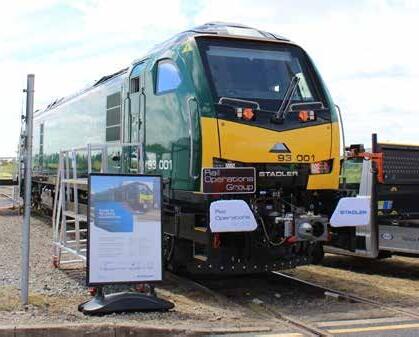
In the safety of the work unit engineers can make repairs on a section of track and are even able to make rolling repairs. The ingenuity of the vehicle was really laid bare when given the chance to explore the vehicle.
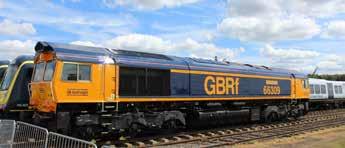
thinking, and Network Rail was keen to demonstrate its new ‘hedgehog’ sleeper, developed with Lankhorst Engineered Products. The hedgehog sleepers are so named because the ends look like hedgehogs nesting under the rail.
The sleepers contain 90% less embedded carbon than wooden models and 78% less than those made from concrete. The sleepers are made up of 90% recycled materials and fully recyclable. As well as reducing carbon emissions, the composite design means for a longer lifespan, reducing the frequency with which they need to be replaced thus minimising line closures.
Protecting the environment also provided a key theme for British Steel which was eager to discuss how it is helping customers meet their sustainability targets. The firm had a section of rail on display, demonstrating the performance of products like Zinoco®, a zinc-rich alloy which extends the life of the rail in corrosive conditions. British Steel also promoted its £10-million rail storage facility currently being built at its Scunthorpe site and scheduled to open this summer.
looked like. Visitors could also test out its Remote Conditioning Monitoring (RCM) technology.
The Network Rail Village was a returning focal point, and this year offered the latest in biodiversity and environmental
Among the many other highlights were demonstrations by the British Transport Police firearms unit; safety sessions with RSSB Chief Operating Officer Johnny Schute; two dedicated seminar theatres ‘Policy & Leadership’ and ‘Engineering’, which boasted many well-known names and generated much food for thought; and many live equipment demonstrations such as that by Pandrol which showcased new tools to streamline the process of thermite welding (above left)
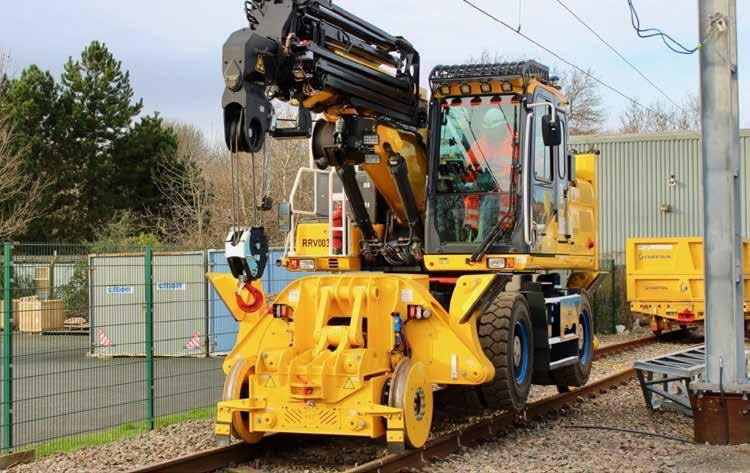



Rail Live was originally established as a plant and equipment show and that is exactly what Rail Engineer was there to see. As ever, looking across the exhibition site, the gaze was met by a sea of yellow machinery, and equipment of all shapes and sizes was there to be wandered around, marvelled at, and discussed in depth.
A Menzi Muck Spider Excavator (centre left) stood pride of place at the stand of landscape and external maintenance services provider Ground Control Ltd. Aptly named, the Spider Excavator resembles a creature more than a machine, with four individually adjustable legs giving it unprecedented mobility and making it a highly versatile piece of equipment for use in challenging environments. The legs can be fitted with either wheels or tracks, depending on the terrain and specific model, and its design offers exceptional stability on slopes up to 45 degrees. It’s
no wonder that the machine is also nicknamed “the mountain goat of earth-moving”. Rail and forestry contractor Coombes also showed off its bigger pieces including its impressive, 34-tonne Sennebogen 728E Tree Handler (top left). With a reach of up to 21 metres, the 728 E fills a gap between Sennebogen’s smaller 718E and the 738E. Equipped with a 9.2-metre compact boom and a six-metre telescopic stick, it covers an impressive working radius and its separate hydraulic circuit can be used to drive other equipment, such as cutting devices, grabs and flail mowers, in addition to the grab saw.
Also on display was a SF02 road-rail milling truck, built by Austria’s Linsinger. With a MAN TGS tractor unit at the front, the unit can be deployed anywhere to provide solutions at small-scale works and support on large-scale projects. The unit switches into reverse, once in rail mode, with the self-propelled trailer milling and grinding the rails at up to 20mph.
SPL Powerlines showcased a wide variety of its machinery including its Doosan Ultimate 270 Teleboom crane (above) which bridges the gap between Road Rail Vehicle (RRV) cranes and excavators. Developed by G.O.S. Tool & Engineering Services Ltd, and owned outright by SPL Powerlines rather than leased, it can be set up in 60 seconds and can lift up to 12,000kg at 17 metres in full 360 rotation. SPL introduced the crane into operation in May, on the Midland Main Line, before it moved north to work on Scotland’s East Kilbride electrification scheme.
Also on show was SPL’s 33-tonne Colmar T10000FS rail loader (bottom left), which was fitted with a Movax DH-25 Piling Hammer attachment. Available in different models, sizes and configurations for different piling requirements, the Movax DH-25 is designed to work on all excavators as well as third party piling rigs or cranes. The tool is sure to prove its worth as SPL supports Scotland to forge ahead with its electrification projects.

Though the larger machinery dominated the event, there was much on the smaller scale to capture the imagination.

Belvoir Rail was proud to showcase the advanced quadruped robots (above left) and augmented reality (AR) headsets and tools it is working on with partners from WMG - University of Warwick.
Designed for rail and rolling stock inspection, Belvoir Rail believes it will revolutionise maintenance tasks. Capable of operating inside and outside trains, as well as on the tracks, they assist with maintenance, fault detection, and minimising failures. The AR technology showcased aims to transform training and maintenance tasks, offering an exciting glimpse into the future of rail operations.
A highlight of the event saw Belvoir Rail (in partnership with Primary Engineer, an initiative aimed at engaging young people with engineering) hosting groups of primary school children on the stand, giving them a practical lesson about its technology and letting them operate the robots themselves.
Earthworks and geotechnical services firm QTS was keen to show off its Bomford-built Flailbot, a wirelessly operated track mower for challenging terrains which drastically reduces operator risk. Powered by a 2.2 turbo charged Perkins diesel engine, the machine can track over rugged terrain without losing power to the cutting head or implement. Additionally, the Flailbot has a ground pressure of just 0.285kg/cm2 which reduces ground compaction. Coupled with its ‘hi-grip’ rubber tracks it is able to undertake work where tractors and ATVs cannot.
Rail handling and logistics firm McCulloch also showcased a range of remote-controlled equipment, highlighting its dedication to innovative solutions for rail maintenance and construction. Of the many items on display were its remotecontrolled Panel Lifter System, Trac Rail Transposer (TRT), and Trac Cable Transporter (TCT).
McCulloch’s Panel Lifter is a unique system that removes and replaces rail panels swiftly and safely. The speed at which it works makes for a more efficient and faster process, an important consideration on projects with limited possession timescales.
With a track record of 15 years, the Trac Rail Transposer (TRT) is a secure and efficient solution for transporting, removing, and installing rail sections and associated ironwork while working under live Overhead Line Equipment.

The Trac Cable Transporter (TCT) (above centre) is designed to lift, transport, and dispense cable from pre-wound cable reels, safely and efficiently. The latest iteration of this rubber-tracked machine can lift and dispense reels of cable up to 1,600mm in diameter and two metric tons in weight.
Rail Live also gives the manufacturers of smaller, handheld equipment the opportunity to showcase their wares and, over the past few years, this equipment has increasingly come to be powered by battery technology.
There was plenty on show from Milwaukee, which displayed a wide range of hand tools for vegetation management. The range included battery-operated hand tools including a pole strimmer which lasts up to 45 minutes on a single charge, and a batterypowered chainsaw which can make up 150 cuts per battery.
Husqvarna’s K 1 PACE rail cutter (above right) is one piece of equipment which stood out. Boasting the power and performance on a par with equivalent petrol-powered cutters, it is able to make between four and five cuts on a single charge. Also of particular interest was the Hilti EXO-T22 tool balancer, which resembled a miniature crane worn like a backpack. The EXO-T can hoist and hold equipment up to 17kg in weight, reducing strain on the shoulders and lower back. The product is just a part of Hilti’s range of exoskeleton wear, and points to a future where wearable technology helps workers complete tasks more efficiently and with reduced risk to their health and safety.
Rail Live 2024 was an excellent event, bringing together the very best of the industry. The day was made all the more pleasant by the excellent weather which added to the great atmosphere, though anyone who forgot to bring their suncream was certainly caught out. With so many sights to see over such a wide area, reporting on a single day does not do justice to the event, but hopefully this report gives a taste of what was on offer.
Preparations for the 2025 event have already begun and perhaps next year a reinvigorated industry will congregate with greater certainty for the future and confidence in Government’s plans for rail.


Unipart Rail is delivering transformative innovations for construction, maintenance and renewal projects.
The global rail industry is facing unprecedented challenges. As rail networks recover from the pandemic, they must also navigate global conflicts, inflationary pressures, labour shortages and supply chain disruptions. These factors have fundamentally altered the cost dynamics of construction work. Despite increased funding, the availability of resources and materials has not kept pace and ageing infrastructure is increasingly strained by climate change.
Changing commuter patterns, with fewer regular commuters and more weekend travellers, add another layer of complexity. This shift requires transportation systems to adapt to irregular and unpredictable usage patterns, ensuring that services are reliable and efficient at all times. It also necessitates continuous maintenance and upgrades to infrastructure to handle varying loads, which can be challenging to manage.
In response, governments worldwide are making substantial investments in rail infrastructure, reflecting a shared commitment to reliable and safe transportation networks. From Network Rail’s £44 billion CP7 initiative in the UK to Ireland’s €35 billion plan, the Biden-Harris administration’s $66 billion investment, Canada’s Go Expansion project, Australia’s 68% increase in rail funding, and India’s 7 trillion rupee modernisation plan, the message is clear: delivering rail projects safely, efficiently and reliably is paramount
The surge in railway traffic is exerting immense pressure on infrastructure managers and maintenance contractors. Heavier and more frequent trains accelerate track wear and tear, necessitating meticulous and continuous maintenance to ensure reliability and safety. However, the limited time available for maintenance due to increasing train operations exacerbates the situation, amplifying the need for innovative approaches.
The rail industry must adopt smarter strategies to optimise available track time while maintaining peak performance levels. This necessitates new working patterns that enhance efficiencies and reduce possession times, allowing operators to address the dual challenges of rising traffic volumes and the need for consistent maintenance.
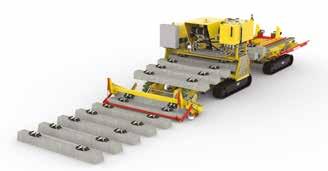





Infrastructure faults can lead to significant financial losses and disrupt passenger and freight services, affecting commuters, businesses and economies globally. Such disruptions erode public trust in rail services and undermine the industry’s reputation for reliability and efficiency. A 2019 report by the Rail Delivery Group highlighted that infrastructure faults cost the UK rail industry a staggering £1 billion. This underscores the universal importance of maintaining railway tracks in optimal condition.
The financial repercussions of construction, maintenance and renewal delays extend beyond immediate costs, including compensation claims, loss of productivity and potential damage to brand reputation.
Therefore, prioritising proactive maintenance, infrastructure upgrades, and the adoption of advanced monitoring technologies is imperative for rail networks worldwide. By investing in comprehensive maintenance programs and predictive maintenance strategies, the global rail industry can mitigate future disruptions, enhance operational efficiency and bolster competitiveness.
Over the last decade, rail networks have invested heavily in specialist on-track plant machinery to deliver rail renewals. These advanced technologies and techniques result in higher-quality track installations, improved track stability and enhanced overall safety and reliability. Additionally, high-output track renewal methods can increase railway line capacity by improving track layouts, alignment and reducing speed restrictions, accommodating growing passenger and freight demands.
Rapid completion of track renewal projects minimises service disruptions, particularly in busy rail corridors and urban areas, where interruptions can have significant economic and social implications. These methods are also versatile, adaptable to various track configurations and conditions, and often incorporate environmentally friendly practices, such as using recycled materials and minimising waste generation.
However, high-output track renewal methods present challenges, including high capital and operational costs, logistical constraints, lack of flexibility, the need for skilled workers, and environmental impact. Their large size poses challenges in restricted areas and their energy and resource demands can have a greater environmental impact compared to traditional methods.
Recognising these challenges, Unipart Rail and Thomson Engineering Design Ltd are working in partnership and are delivering a range of transformative, sustainable and performance enhancing solutions for rail construction, maintenance, and renewal projects, which are redefining industry standards and elevating operational efficiencies across the global rail market. Together we are introducing a new range of machines designed to overcome the limitations of traditional high-output methods, delivering high performance, safety and efficiency, whilst substantially reducing costs and carbon. The new range includes:
» Sleeper Layer: Providing delivery rates of up to 1000 sleepers/ties per hour, and offering a variety of options including automatic steering, remote condition monitoring and diagnostic support. The Sleeper Layer is exclusively available to hire from Story Plant in the UK.
» Rail Handler: A versatile, multi-purpose machine offering a variety of applications and benefits for installing, removing and transposing rails.
» Rail Clipper: A unique self-propelled, road-rail clipping machine with applications in rail maintenance and track renewals operations.
The key features of these groundbreaking machines include:
» Increased safety: Our new machines enhance safety by minimising human involvement and potential hazards. By removing the operator from the machine, the risk of accidents is significantly reduced.
» Cost Savings: With lower capital investment and operational costs, in
addition to reduced labour requirements and enhanced productivity, our machines enable significant cost savings for rail operators.
» Efficiency: By automating repetitive tasks and optimising workflows, our machines drastically reduce the time required for rail projects, leading to increased efficiency and faster project completion.
» Rapid deployment: The new machines are designed for rapid deployment, with shorter possession times and easy transportation to sites without additional equipment. This allows work to start immediately, increasing productivity during possession periods.
» Advanced technology: Incorporating state-of-the-art digital technologies, such as automation, our machines offer unparalleled precision and accuracy in rail maintenance and renewal tasks, leading to high quality, sustainable infrastructure and safer working environments.
» Versatility: Designed to handle a wide range of tasks, from track renewal to ballast maintenance, our machines offer versatility and adaptability to meet the diverse needs of the global rail industry.
The rail industry stands at a critical juncture, requiring innovative solutions to address the growing challenges of maintenance and renewal. The partnership between Unipart Rail and Thomson Engineering Design Ltd offers a transformative approach, delivering solutions that are more productive, safer and sustainable.
By embracing modern technologies and advanced engineering principles, we are empowering rail operators and contractors to achieve unprecedented levels of performance and reliability and are paving the way for a new era in rail maintenance, ensuring that rail networks worldwide are ready for the future.
Contact us at railplant@ unipartrail.com to learn more, or scan the QR Code:

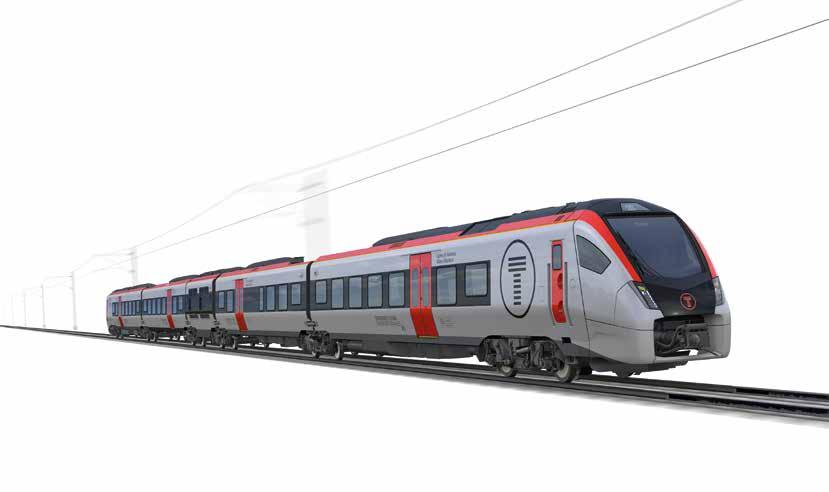
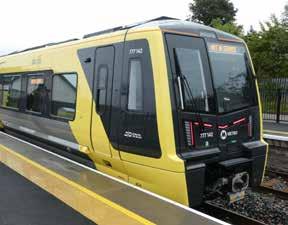



The UK’s railway currently runs over 50% of passenger train and over 95% of freight train mileage on diesel power. If its railways are to decarbonise, this must change. There is no debate about that, but plenty of debate about how. In practice the trains will all probably be driven by electric motors. The debate is how that electricity gets from generation source to the train.
Conventionally there are three main methods proposed: conventional electrification via overhead wires or third rails; power to charging stations to recharge battery powered trains; and electrolysis of water to form hydrogen which is then transported to the trains and reconverted to electricity in a fuel cell. Also, environmentally friendly internal combustion engines powered by an environmentally friendly fuel (hydrogen, ammonia, or biodiesel) might be possible – see later in the article.
All the options have disadvantages: conventional electrification is costly; batteries are costly in whole life terms and have limited range; and the green hydrogen cycle is incredibly inefficient, although hydrogen might be manufactured cheaply from surplus wind or solar power. For freight, the only practical option is conventional electrification with, perhaps, batteries for last mile operation to avoid wiring complex yards or industrial premises.
All the options require electrical power, placing demands on the national grid which, it is fairly clear, has major issues in providing enough capacity as demand for electricity rises.
The Institution of Mechanical Engineers Railway Division often holds topical seminars and in March 2024, it discussed Innovation in Traction, covering these and many other issues.
Setting the scene, Rich Fisher from the Great British Railway Transition Team (GBRTT) outlined many issues and scenarios. In 2020, Network Rail’s Traction Decarbonisation Network Strategy (TDNS) proposed comprehensive electrification with minor and niche roles for battery and hydrogen trains, respectively. GBRTT suggest that lower cost options with a significant role for battery trains would bridge the gap between electrified sections of railway and extend electrification’s benefits.
Having examined several scenarios, a targeted electrification option would cover key freight routes, the remainder of the original Great Western scheme, and the line to Hull electrified, in addition to work already in progress. Lower Capex cost options lead to increased Opex due to continued reliance on diesel traction. That said, GBRTT expects rail to need carbon offsetting and alternative fuels beyond 2050.
Given that range-extending battery/electric trains will need to charge their batteries from the existing electrification system and electric freight locos will also draw more power, some power supply upgrades will be necessary. After all that there will still be a few diesel vehicles around by 2050 and there might possibly be a role for a small number of hydrogen or some other independently powered trains.
Neil Ovenden from Rail Partners summarised how passenger traffic had recovered, but changed since the pandemic, and outlined some of the challenges to procuring future trains proposed by Rich Fisher and others. Firstly, the procurement process had become more complex compared with the pre-2020 situation when TOC owning groups invited tenders as part of their franchise bids. TOCs operating under National Rail Contracts are effectively in the public sector, so TOC-led procurements now have to be carried out to the requirement of the Utilities Contract Regulations 2016. Operators procuring trains also now have to follow the Strategic Outline, Outline and Final Business Case process before inviting tenders (not open access TOCs).
Professor Stuart Hillmansen from the University of Birmingham introduced an overview of the science applicable to various energy sources and how they might be applied to typical railway duty cycles. It’s often said that rail is a very small contributor to carbon emissions. For context, an
carrying out hydrogen safety research as part of the EU HyTunnel project (https:// hytunnel.net/), focussing on jet fires and ignition delay effects especially in tunnels.
For testing, a close to full size tunnel was built at HSE’s 550-acre Buxton site. HSE aimed to assess the effect of a credible failure of a hydrogen storage system releasing hundreds of grams of hydrogen per second. Illustrated by some truly scary videos of the tests, it was concluded that hydrogen release in tunnels is a big risk.

Design requirements are changing too. The leisure market is increasingly important and, far from merely demanding the maximum possible number of seats per coach, leisure customers also want space for bikes, buggies, and luggage. Wider doors and level boarding access are also increasingly expected and not just by people with disabilities. That said, a large proportion of platforms do not currently comply with the required height/offset to readily deliver level access and will require work. The third challenge for TOCs, and back to this seminar’s topic, is what traction power type(s) to specify when the extent and capability of future electrification is still uncertain.
There is clearly a short/medium term demand for ‘off the wires’ power which needs to be addressed while also reducing the use of diesel power and emissions. Some of this might be addressed by fleet cascades, but there are many uncertainties about demand for legacy fleets, and it is costly to upgrade them to modern requirements. Also, there can be an uncertain timeframe to amortise upgrade costs.
Customer requirements change a little over time but the basics of reliable/punctual, clean, and uncrowded trains remain the top three. Traction battery and rapid recharge facilities, better internal air quality and temperature management, the ability to upgrade on-train IT rapidly and frequently, easy cleaning, and comfortable seats are also likely to be important requirements.
batteries add weight and lack range, and whilst hydrogen fuel cells can provide range, they also need batteries – think hydrogen fuel cells as a range extender for battery trains. None of these options provide the capability of an electric train that can draw typically 7.5MW from the overhead line.
Ignition of the escaping gas from an overpressure valve is bad, but later ignition after the hydrogen has mixed with the atmosphere is even worse. That said, they have established that a hydrogen jet fired directly onto a concrete tunnel wall is unlikely to cause
Neil Dinmore and Darren Fitzgerald from RSSB discussed fire safety standards for alternative-powered rolling stock. Given that a standard is generally intended to be the collection of relevant requirements determined from industry experience there had been a great deal of research, and 15 RSSB projects were cited. Standards need to cover the electricity supply, hydrogen supply, and storage/handling risks both on and off train. RSSB has commissioned modelling, day in the life reviews, and risk assessments for loss of containment of hydrogen.
*These
It is also important to consider how energy is used. The objective is to deliver the desired run time using the least energy. For frequent stop services, accelerating hard plus reasonable top speed and some coasting before braking hard, uses the least energy, and allows some make up time if running late.
Kieron Lyons from the Health and Safety Executive discussed some of the safety risks from using hydrogen as a fuel. HSE’s Science Division has been
Batteries have been the subject of research project T1272 ‘Compatibility and optimisation considerations for rolling stock traction batteries and battery charging’. Fire safety of batteries and how to extinguish fires that may occur is also under review, especially after a fire on one of the vehicles involved in the Carmont accident in 2020, which started some 45 minutes after the collision. With much bigger batteries fitted to self-powered and battery electric bi-mode trains there is a significant fire risk although choosing the right battery technology minimises that risk. Comparisons to deliver 1 MWh


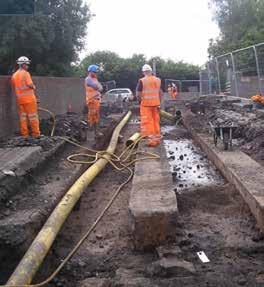

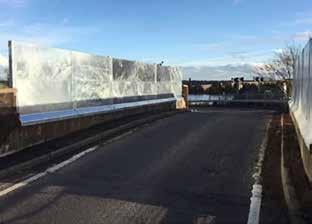



Dr Dawei Wu from the University of Birmingham discussed the potential for ammonia as an alternative fuel in rail. His team’s work focusses on safely and efficiently using ammonia in internal combustion engines, without releasing the gas into the atmosphere. A slide showing volumetric energy density vs specific energy density showed clearly how good petrol and diesel are. Ammonia has approximately three times the volumetric energy density of hydrogen (including storage containment), but about one third that of diesel fuel. The direct combustion of neat ammonia presents challenges due to its high ignition energy, narrow flammability limit, slow burning velocity, and NOx and N2O emissions when air is used as an oxidant.
Issues affecting the use of ammonia in internal combustion engines were discussed, including the pressure and spray pattern from injectors, use of fuel enhancers, the benefits of lean mixture burning, low oxygen dilution/ exhaust gas recirculation and humification. Ammonia fuel engines are not new – they were used during World War 2 - and are seen as a promising solution for large bore internal combustion engines for the marine and power generation sectors. That said, solid oxide fuel cells (SOFC), a relatively new technology, are adaptable to use ammonia as well as hydrogen. The SOFC is an electrochemical conversion device which operates at high temperature (600°C to 800°C) and needs no expensive platinum group catalyst metals. It might also be possible to retrofit existing high power rail diesel engines to run on ammonia.
Richard Stainton, Network Rail’s electrification expert, returned to the subject of OLE and delivering better electrification more cheaply. The cost of an electrification scheme is roughly one third civils works (tunnels, stations, bridges), one third electrification (OLE, traction power) and one third everything else (signalling immunisation, fencing/de-vegetation, mobilisation, authorisation [NTSN etc.], TOC compensation).
Key issues discussed included:
Over bridge parapets: Until recently, standards mandated a minimum height of 1.8 m. Delivering this work to the required strength can lead to the carriageway width being reduced below acceptable limits and/or wind loading might require bridge strengthening. In extreme situations the bridge might need to be replaced. New Network Rail Standard NR/L2/ELP/27717 covering bridge electrical risk assessment allows risk assessment based on the likelihood of mischievous acts and spend proportionate to the risk.
OLE bridge design: Many bridges have been reconstructed during more recent OLE schemes to achieve clearances, but the cost and disruption has been significant. No doubt the bridge asset manager is delighted to have a new bridge on someone else’s budget, but is it expensive to prematurely replace an asset with possibly decades more life. Methods of minimising clearances have included voltage-controlled clearances (surge arrestors/earth connection) and better understanding of real world catenary uplift from passing pantographs.


Over 30,000 surge arrestor tests have been successfully carried out at and in conjunction with the University of Southampton with clearance gaps down to 20mm. A good example is the small clearances provided under the Cardiff Intersection bridge, a steel bridge carrying a rail line over the main line (Issue 190, May/June 2021).
Insulated pantograph horns: The horn - the curved run off area either side of the contract trip on a train’s pantograph - is typically conducting. This is sometimes an issue close to, for example, legacy station canopies. Simply converting this to a non-conducting material reduces arcing risk. This has now been thoroughly tested and proven.





Ice loading: The design of the OLE has to allow for the formation of ice which impacts on the strength of masts, catenary wire droppers and gauge. The origin of the requirement – a 9.5mm thick coating of ice around the conductor – was not known, but following extensive research was eventually traced to a requirement for electric telegraph wires from 1886, the last recorded time the river Thames froze over! More recent modelling by the US military has shown that the risk of significant ice build-up is negligible. Icicles in tunnels is a much bigger risk.
The number of OLE masts required has been the subject of extensive work to understand the effect of wind on the conductors leading to approval to increase span length from 65 metres to 95 metres. Network Rail has also worked with University of Birmingham and Deutsche Bahn to improve understanding of wind loading and benchmark each other’s OLE mast and foundation designs.
The provision of traction power has also been reviewed, given that the architecture used until recently was developed over 50 years ago. The new architecture provides for modern protection technology and modern traction packages and features fibre optic comms and IEC 61850 safe and secure remote control. This delivers benefits of reduced switchgear, reduced land requirements, reduced construction time, improved speed of protection and real time traction information.
Joshua Fanshaw, and Eliot Clark from Siemens Mobility discussed battery charging and solid state frequency converters (SFC)
Germany was an early convert to AC electrification, long before diodes, thyristors, or transistors were invented. To the untutored eye, a traction motor for one of these early electrification schemes looked like a DC motor but ran on AC. To get the right performance, the solution was to run on AC at one third of the mains frequency, 162/3 Hz. To achieve this, the supply to the railway was distributed as a railway dedicated two
phase, 110kV 162/3 Hz railway. Traction at 15kV could be drawn from the 110kV supply at various transformer substations. To provide the dedicated supply, large rotating frequency converters were required, the predecessor of the SFC. 50Hz to 50Hz SFCs have begun to feature in UK’s electrification schemes

and offer several advantages. They take the three-phase supply and convert it to single phase which eliminates the issue of unbalanced loads on the individual phases of the mains supply, opportunity for paralleling, no need for neutral sections, a controlled constant output, and low fault currents (especially compared to high power auto transformer supplies).

A variant of the SFC was described as the Rail Charging Converter (RCC). This is intended to be connectable to the UK 11kV grid network where connection points are much more extensive than are available with the 400kV/ 275kV / 132kV networks. If used on a low-density intermittent electrification scheme it could be sited where needed and not according to where the power is available. It avoids difficult, expensive areas, such as tunnels, bridges, and level crossings, avoids long power cables from out-of-town supply points running through limited clearance areas, and perhaps avoids long lead times for large scale connection points. The RCC provides a scalable 2.5MW output at a nominal 25kV from a 11kV to 3kV input voltage. A trial installation is to be tested at Porterbrook’s Long Marston site in 2025.


The last speaker, Professor emeritus Felix Schmid from the University of Birmingham, postulated an opportunity for further energy efficiency on metros by proposing a 3,000VDC supply, potentially on third and fourth rails. He stated that DC is usually deemed appropriate for urban rail where services are frequent. Tunnels must be much bigger for 25kVAC electrification and it is not suitable for street running, even where it is not prohibited by law. Moreover, it makes sense for metro trains, which accelerate and brake frequently, not to include the mass of a 25kV transformer and its protection systems.
Alternating current at low voltage suffers large volt drop due to relatively high resistance, the skin effect and inductance. Presently, trams use 600VDC or 750VDC with OHLE, and metros 750VDC with third rail, whereas other metros opt for 1,500VDC, mostly under OHLE. The London Underground third and fourth rail system uses a floating earth arrangement (except where it shares tracks with other operators’ third rail trains) where either rail can be at 750V relative to earth, but is usually biased approximately +500V/-250V. Direct current systems suffer quite high volt drop necessitating frequent substations, but the 3,000 VDC proposal increases the spacing and each pantograph/pick up shoe has to carry less current. A third and fourth rail split roughly +1,500V/-1,500V was proposed but, whether this would be with a floating earth system, is not yet determined.
Whilst not in use anywhere, there might be advantages for fully segregated metros (e.g., fully underground or on viaduct with platform screen doors). These are:
» More suited to large city metros where trains are becoming heavier.
» Limitations of 1,500VDC OHLE are becoming apparent, particularly in terms of pantograph wear.
» Voltage drops require shorter spacing of substations and more capable substations.
» 1,500VDC 3rd rail electrification is now being accepted for fully segregated metros, notably in China.
» Technical developments make 3,000VDC entirely feasible.
In short, having more power available, fewer substations, halving current, reduced voltage drop and transmission losses look attractive, but the approach requires a full scientific and technical analysis.
Your writer attended the conference with a firm view that electrification is still the way for heavily trafficked passenger and freight lines. Was his mind changed? In short, no, although he recognises that branch lines might justify other solutions and that complete system decarbonisation might be achieved a lot later than 2050. It is accepted though that hydrogen or ammonia might be suitable for other transport modes where a tethered power supply is impractical or impossible. One cannot, for example, imagine OLE on the open seas!




The first thing to note is that providing Wi-Fi on trains is relatively straightforward. It’s providing internet connectivity to the trains Wi-Fi system that is tricky. This is similar to having a great mesh Wi-Fi system in a building, but with a poor broadband internet connection. No matter how good the Wi-Fi is, without a reliable, good-bandwidth broadband connection to the building the end service to the device and the customer experience will be poor. It is the same with a train.
With widescale societal use of internet connectivity, both for leisure and business purposes, there is an expectation by many that a connection to the internet will always be available on a train. It is said by some studies that, on average, people spend more than 25% of their waking day online and for nearly two thirds of people not having reliable internet access is the cause of significant stress when they are out and about. Workers are increasingly flexible with remoteworking and they need to be able to use trains as a place of work when travelling.
However, trains are fast-moving, often densely populated metal boxes which shield radio signals. Connectivity ‘on the go’ needs seamless handover between Mobile Network Operators (MNO) base stations and Wi-Fi access points within the train itself. Good network capacity planning is also needed to handle the load efficiently and provide satisfactory service to all passengers.
It is possible to obtain internet connectivity direct to devices, such as smartphones on trains, without Wi-Fi. However, by virtue of their construction, train vehicles create attenuation which degrades the usable signal into the train vehicles. This can typically be between -5 to -35dB, with a loss of
3dB resulting in halving the available power. The rail network in Great Britain extends for some 15,750km, of which 6,300km is in cuttings of various depths, and this creates further difficulties in providing continuous coverage to and from MNO base stations. Another problem is that such is the popularity of Wi-Fi that nowadays many devices, such as laptops and tablets, are only provided with Wi-Fi and do not have an MNO connection. This means a reliable good quality Wi-Fi service has become an expectation of rail travel.
The most common method of providing a train internet connection to the Wi-Fi system is by using an external mounted wideband antenna connected to a communications device known by some providers as a Mobile Communications Gateway (MCG). The MCG, or a number of MCGs, provide ‘a cloud’ of connectivity to the train via several MNO services (and, where available, external Wi-Fi connections at stations) aggregated together.
The internet connection is provided throughout the train via a number of internal vehicle Wi-Fi access points, typically using the train’s Ethernet network with appropriate security and firewall protection. Robust inter-vehicle connections are
used to connect the access points, or point-to-point Wi-Fi may also be used to connect access points. These use low power and directional antennas to minimise the risk of bleed through to adjacent trains. Security is also very important, which requires encryption and authentication to protect passengers’ sensitive information. The security threat is always changing, and the defences must be continually upgraded.
Over the years, providing internet connectivity and Wi-Fi on trains has become ‘a victim of its own success’, with the use of devices on trains increasing dramatically and applications such as Netflix, YouTube, or any streaming service, needing access to extensive data bandwidth, and far more than the Wi-Fi systems on trains were typically designed for. Wi-Fi service on a modern busy train using aggregated MNO links can be likened to a fast-moving street with several people in each house ‘gobbling’ data and with only one poor broadband connection for the entire street!
Another problem is that the MCG, Wi-Fi Access points, and train Ethernet networks quickly become obsolete and need upgrading or replacing every few years - far more frequently than the typical mid-life upgrade refurbishment timeframe of a train. The MNO links will also need paying for, but the train customers expectation is that the train Wi-Fi service will be free, just like it is in most public areas outside of rail. All this means that the on-train Wi-Fi service available on some trains has become embarrassingly limited, resulting in poor passenger satisfaction scores.
The 44-mile South Western Railway scheme deployed by First Group PLC (owners of the SWR franchise) uses dedicated small mmWave wireless access points every few kilometres, developed by Blu Wireless Technology Ltd based in Bristol. The LightningBlu, Blu Wireless solution provides symmetrical Gigabit data throughput and low latency connectivity between trackside and train, using the 57GHz to 71GHz unlicensed frequency band. This is a huge improvement over the solutions based on aggregating MNO services deployed on most trains to provide on train Wi-Fi.
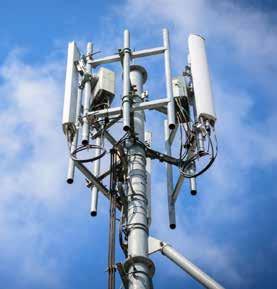

A number of initiatives have been developed to aid installation and reduce costs. For example, the Stanchion Mounted Pole (SMP) is a lightweight, nonconductive plastic pole attached to an electrification stanchion. This removed more than half of the survey requirements and made installation far easier and quicker. Unfortunately, the GHz frequencies need frequent (every few km) fibre cable break out points and power supplies, which are difficult and expensive to provide. It is also possible to use point-to-point radio links to serve the access points instead of fibre, but again a local power supply will be required, although this situation may improve with the development of localised green energy sources, such as solar.
All is not lost though, as Blu Wireless’ gigabit wireless solution has recently been boosted by a deal with Westermo which is a manufacturer of data communications solutions for mission-critical systems in demanding environments, such as rail transport, utilities, mining, and petrochemical industries. They have acquired a stake in Blu Wireless, a seat on the Blu Wireless board, and a strategic partnership agreement to use the mmWave wireless technology in the rail market. Westermo already provides many data network products and solutions on trains and has extensive international experience. They are very well placed to further commercialise the mmWave technology in the rail sector along with the development of future products.
Deploying fibre cable trackside may not be easy, especially with the difficulty of working trackside safely, but the availability of high-fibre-count ribbon fibre cable helps, and it should be possible for the rail industry to work more efficiently and, for example, run fibre cable for trackside Wi-Fi points when resignalling work takes place.
Modern signalling systems also tend to use a more distributed trackside architecture approach which also needs power supplies. The GSM-R operational train radio masts (although provided for operational communications, not public use) are also located every few kilometres and with power. So, with better planning and collaborative working the industry could reduce costs and provide better train Wi-Fi.

Internet connectivity via satellite connection is now commonly available for fixed use and on passenger aircraft, which raises the question of whether this could be used for trains? The answer is yes it can. Twenty years ago, a project called ‘Broadband to Trains’, partly funded by the European Space Agency (ESA), demonstrated the use of satellite communications to deliver broadband internet access to a train’s onboard system. Since then, Low Earth Orbit (LEO) satellites systems have been introduced with reduced latency and lower cost. LEO satellites orbit the Earth, typically at a height of 180 to 2,000km (111 to 1,242 miles). Just over 100 miles may not be low, but it is significantly lower than the traditional geostationary orbit (GEO), satellites which are over 37,000km (23,000 miles) from Earth. LEO satellite networks are becoming popular because of their reduced latency and the lower levels of rocket power (and therefore cost) needed for launching.
GEO satellites can cover huge areas with a single satellite due to their height, but LEO satellites have to be deployed in ‘constellations’ that work together to provide coverage for larger areas. LEO satellites travel around the Earth typically every 90 minutes so they can’t keep ‘hovering’ above one specific area like a GEO satellite. LEO satellites are fast moving and can move in and out of range of receivers in just a few minutes. This means that the satellite dishes and receiving devices are more complicated, having to track the movement of the satellites, and constantly switch from satellite to satellite depending on which is closer. By their nature, passenger aircraft are closer than trains to LEO satellites, they don’t run in cutting or tunnels, and their receiving dishes are more stable. However, a lot of work has been done in this area and LEO satellite train internet systems are now being developed by several bodies, including European Union’s rail system authority (ERA), Europe’s Rail Joint Undertaking (EU-Rail), and the European Union Agency for the space programme (EUSPA).
In 2023, global satellite operator OneWeb undertook trials in the UK to use its LEO network to serve railways, with the aim of “providing resilient broadband for both operations and enhanced passenger experiences.” Called Project Sodor, in 2023 OneWeb tested a user terminal installed on a rail car on the North Yorkshire Moors Railway. More currently, The Clarus Networks Group is developing and trialling an efficient rail approved vehicle satellite ‘dish’ it refers to as a “tile”. Clarus is an agent for Starlink, the world’s first and largest satellite constellation with thousands of LEO satellites already in place.
Trains run in many deep cuttings and tunnels, along with travelling in many built up cities. Therefore, LEO satellite train connection systems may need supplementing with fixed fibre connected base stations.
Using LEO satellite connectivity for operational purposes may alarm some and may be considered to be a step too far, but it is already being suggested as a possible bearer network for the Future Railway Mobile Communication System (FRMCS). Certainly, high bandwidth lineside Wi-Fi connectivity would help immensely with non-safety operational railway applications.
Wi-Fi on trains will still need funding, but the industry and UK Government needs to look at on-train Wi-Fi as a service to improve rail use and not as a standalone business. Wi-Fi on the railways will help to increase productivity in the economy. Commuters can work on the go and leisure travellers can connect with friends, research their destination, and check live journey information. Since the pandemic emergency lockdowns, the level of train use is recovering, with the exception of first class. However, good quality Wi-Fi is essential for making the most of a business trip and working on the move.
Last year, the Department for Transport said it was looking to remove free Wi-Fi services unless train operators could demonstrate a business
case. This was, however, based on a survey where passengers were asked what their priorities were with regards to safe stations, trains being on time, and clean toilets - hardly robust proof that Wi-Fi service is not seen as a requirement by passengers and is no longer justifiable. Good reliable connectivity is also of great benefit to onboard train systems such as CCTV, passenger information, and Train Control & Management System (TCMS) reporting.
Other countries are committed to providing on train Wi-Fi. For example, in Germany the government, Deutsche Bahn, Ericsson, Vantage, and O2 Telefónica are looking to bring better connectivity to railways, and the Gigabit Innovation Track (GINT) project is looking at the technical and financial options. In the US, Caltrain is rolling out the Blu Wireless mmWave system along the San Francisco to San Jose rail corridor with Alstom Nomad the prime contractor.
The new UK government, while supportive of rail, is going to have some very tough decisions to make, but let’s hope that Wi-Fi on trains is seen as an important service to grow rail travel and the economy, rather than a simple business case in its own right. A good internet connection and a reliable, affordable train service do not have to be viewed as separate issues. Consumers value reliable, uninterrupted internet access, and meeting the technological challenges will open new opportunities for rail use consumers.

The technological challenges of providing Wi-Fi on trains can be overcome, but it needs scalable infrastructure designed for trains, possibly deploying a combination of wired and wireless connectivity, using technology such as mmWave wireless with fibre-connected access points, wireless back haul, and satellite connections. The typical train onboard architecture is also in need of re-evaluation to fully meet future requirements, as these have not really evolved since the early 2000s.
The future of train Wi-Fi needs the development of cooperative solutions, affordable investment, and a robust industry strategy. Not the abandonment of in-train internet connectivity.




Beaulieu Park is a new station being built on the Great Eastern mainline northeast of Chelmsford city centre adjacent to junction 19 of the A12, the Boreham interchange. This will be the first new station on the Great Eastern mainline for over 100 years.
The railway is busy with longer distance traffic from Norwich and Ipswich and more local traffic from the Essex and Suffolk coastal towns. Finally, there is significant rail freight primarily from the port of Felixstowe. All this is handled by a twotrack railway albeit with substantial bi-directional signalling. So, building and operating a new station was not going to be easy, indeed one of the constraints is the need not to reduce freight capacity or to add time to freight train journeys as a result of the new station.
The northeast of Chelmsford is subject to much wider regeneration and development of the Chelmsford-Braintree corridor with plans for up to 14,000 new homes, a new north-eastern Chelmsford bypass, as well as new schools, retail, and leisure facilities. Support for the new station came from the Chelmsford City Council and Essex County Council partly because of the cramped nature of the city centre station in Chelmsford which, with 5.7 million annual users in the year ending March 2023 is one of the busiest two platform stations on the national rail network according to Office of Road and Rail (ORR) data. The city centre station is on an elevated section of railway and has limited parking, or even drop off, for rail travellers arriving by car. The new north-eastern bypass will make access to the new
station from surrounding towns such as Braintree much easier and relieve congestion in Chelmsford city centre. Beaulieu Park thus became a station to serve both a significant residential expansion of Chelmsford, provide a wider local catchment, and reduce congestion around the city station.
As with many such ideas the project has had a long gestation. Outline planning permission was granted in 2013 but it took a further eight years to get funding in place. As a result of requests from the City and County councils, The Department for Levelling Up, Housing and Communities is providing £218 million of funding via Homes England while the housing developers, Countryside and L&Q, together with the South East Local Enterprise Partnership, are providing a further £34 million. This allows both Beaulieu Park station and the new Chelmsford north-east bypass to be constructed.
The Chelmsford north-east bypass links to the Boreham interchange on the A12 and is fundamental to gaining access to the new station. The funding was in place by June 2021 which enabled final designs and physical work to commence. The funding source means the primary client for the station is Essex County Council with Network Rail overseeing the construction and railway facilities. Final design was contracted to Murphy. A second contract for the physical construction of the station was also awarded to Murphy in September 2023 at a cost of £124 million.
The site of the new station has various constraints as a result of past use of the land, quarries and historically protected parkland, as well as future plans, and thus could only accommodate a relatively short section of expanded railway. Extensive modelling to

demonstrate the effect of placing a busy new station on rail traffic capacity and running times, especially of freight traffic, was conducted. This concluded that the station should be built with three tracks and platforms, an up and down main, and a central loop, all of which will be bidirectional. The current line speed of 100mph will be maintained on the up and down mainlines, while the central loop line will be subject to a 50 mph linespeed as will the associated point work. The three platforms will each be 250 metres long and thus capable of handling 12-car trains of 20-metre carriages or the equivalent. Canopies are provided along two-thirds of each platform.

The station buildings on the downside of the railway involve significant ground works to prepare a level site supporting ease of access. There will be an Access for All (AFA) footbridge equipped with lifts as the main means of gaining access to Platforms 1 and 2 and a secondary means of escape (SME) footbridge toward the country end of the platforms. The station will have bus interchange, taxi rank, drop off zone, and cycle parking in addition to a 243-space premium car park which will be operated by Chelmsford City Council. There will be another 462-space car park to the east of the station, situated beyond land which needs to be safeguarded for the future North-East bypass. This car park will be provided with pedestrian access.
Station facilities will include ticket vending and gate line, general and accessible toilets with baby changing facilities, waiting areas, and catering and retail outlets. The scheme has been designed to minimise the impact of the station on the new parkland setting to New Hall, a Grade I listed building surrounded by a Grade II registered park and garden. This has restricted the height of the station building. Indeed, the highest part of the station is the AFA footbridge.
The station building itself is intentionally different from other stations in its design. Essentially, the building comprises a larch glulam roof – that is, an overall roof constructed of laminated and glued larch wood – supported on independent pillars, with all the internal structures including retail outlets and office accommodation being free standing within the space provided.

Building such a station on a busy and critical mainline would either mean taking many short duration possessions of the railway or finding a way to keep the railway open while construction took place. Unsurprisingly, the latter was the chosen option leading to the realignment of the final railway in several substantial stages of work. The first stage required Murphy to build up the land on the downside of the railway prior to construction of a realigned down line and its platform (3) and the loop line and its platform (2). This entailed moving around 80,000 tonnes or somewhat over 40,000 cubic metres of material to level the land.
During this period, rail traffic continued uninterrupted on the existing up and down lines while the substantial work took place on this stage of the project. From a permanent way perspective, the new alignment for the down main and loop line and associated platform faces were built including the installation of eight point ends to provide full bidirectional flexibility
for the final layout. All works that would otherwise require engineering possession of the railway were installed to avoid later disruption to train services. The overhead line equipment for the revised alignment was prepared, new signalling location cases and relocatable equipment buildings, together with the new signals and train detection apparatus, were installed. This work was completed during 2023.
Over Christmas 2023, the project entered its second stage when a full possession of the railway slewed the old down and up lines to connect with the new down line and loop line, respectively, and disconnected the former alignment. Being an electrified railway there are also the associated changes to the overhead line equipment which was upgraded through to Chelmsford station. Down trains now run through the station via what will be Platform 3 while up trains run via the loop line through Platform 2. At this stage the signal interlocking has not been altered so the points are clipped and padlocked out of use. Thus, although the actual signals and
train detection equipment for the new track are in use, the interlocking is still configured to regard this as part of the original up and down mainlines. This enables stage three, the construction of Platform 1, including canopies and the final alignment of the up line to be completed again without the need for possession of the railway.
This part of the work is currently in progress and includes, as was the case for the other platforms, installation of preformed platform faces with associated backfill and top surfacing of the platform. In due course, stage four will reconnect the new up line to the rest of the route thus delivering the final three platform station.
The GE mainline in this area is signalled using Solid State Interlocking (SSI) controlled from Liverpool Street signalbox using an Integrated Electronic Control Centre (IECC). Consequently, many of the signalling changes relate to amendments to the data configuring the system although of course there is additional lineside equipment to drive new points


In terms of the station building, Murphy has completed the major earthworks and drainage to prepare the site - the station shell and roof were erected during 2023. Through 2024, in addition to the creation of platform one, the station works will be completed including the access for all footbridge and the emergency footbridge both of which were due to be installed over the late May 2024 bank holiday and will result in the station appearing, at least from an external perspective, to be almost complete.
There will then be the associated lifts together with other station facilities, such as gate lines, toilets and information systems and with retail outlets to be completed some of which will involve the train operator Greater Anglia. The project team is currently aiming to complete this work together with submitting the necessary paperwork to gain approval for use during 2025.
and signals as well as amendments to train detection sections. It is at this stage that the main signalling alterations will become active and thus require robust testing and verification.
When stage four is complete the railway will revert to a bidirectional 100mph route on the up and down lines with the loop having a linespeed of 50mph in both directions. This is planned to occur in late December 2024. Upon opening, the opportunity will be available for the train operators to enable one train to pass another that is running out of schedule; an important benefit given the two-track nature of the route both east and west.
While the station itself and immediate surrounding area is the responsibility of Murphy and Network Rail, much of the external area including access roads and the more general ‘urban realm’ around the station falls to the local authority to complete. In addition, the need for facilities such as bus routes and taxi provision has to be arranged but is outside the immediate scope of the station construction. Thus, a final opening date during 2025 is yet to be confirmed. This will be announced by Essex County Council in due course.
While Murphy have been the prime contractor for the project it involves many other specialised disciplines. The major sub-contractors have included Pod Trak for track and OLE work, Amaro for the signalling work, and DPH for the Electrical and Power works and operational communications.
My thanks to Ian Bland, portfolio manager, Network Rail, and William Ross project director for Murphy, for discussing the project with me and showing me around the site, and to Stephen Deaville, senior communications manager, Network Rail for organising the site visit on which this article is based.















When in any big city around the world, the chances are you will ride on its metro or underground system. But knowing which line to travel on and the station to get off at can be a perplexing experience, especially if you are not used to this mode of travel. Much will depend on the information you are supplied with, be it paper maps, signage at the station, or indicator systems once you are on the platform.
London is probably the most visited city in the world and most tourists, as well as the local inhabitants, will use the underground system on a daily basis. Getting meaningful and accurate information out to passengers is a vital part of the train service offering and has been ever since London Underground began operations in the Victorian era. A recent talk given to the IRSE London & South East section informed the audience of the history of passenger information and how modern day IT and train tracking systems bring sophistication and accuracy to the display screens.
London Underground (LU) has provided platform displays for over a century. These may be summarised as follows:
» Indicator boxes with all destinations printed on enamel plates. An adjacent light box illuminated an arrow to indicate the first train. At some stations and where a train describer system existed, the sequence of approaching trains would be shown by illuminating 1, 2, 3. The system dates from 1906 but only one remains today at Earls Court where it is a listed feature.
» Light boxes. Train destinations printed on transparent glass compartmentalised within a box. Once the train destination is known, the correct compartment is lit up.
» First train indicator. These date from the 1960s but only show the destination of the next train and all are now removed.
» Two train indicator. An improvement on the former showing the destination of the first and second trains but nothing else.
» Dot matrix displays. These are now installed at virtually every station. The system dates from 1981 and was a 17-stage project to provide indicators at 340 platforms. Using Light Emitting Diode (LED) displays, not only do they show the destination of the first, second, and third train, with sometimes a fourth train, they incorporate a countdown feature that informs the time in minutes for the arrival of each of the trains displayed. Additional safety information is also displayed – see picture.




At important interchange stations, displays may be provided at locations between the concourse and the platforms to indicate the times of the next trains from each of the platforms. An example is at Euston where the Northern Line is served by two different branches with trains to the same destination (e.g. Edgware) being from two different platforms. The traveller then knows from which platform to go to for the first train. When first introduced, an average station cost around £12,000 for the indicator provision, nowadays this is typically £34,000. On some lines, e.g. the Metropolitan northwards from Baker Street, some trains to the most northerly suburbs do not stop at all stations. The stopping pattern is indicated for the first train using a second line of text.
» Summary displays. Sometimes referred to as Rainbow Boards, these are positioned in the concourse areas of LU stations that typically serve the main line termini. They show the service level on all the LU lines to indicate whether any delays or line closures are taking place at the current time. Originally these showed the level of service on every line but the display has been simplified to indicate lines where disruption is occurring with an added comment ‘good service on all other lines’. Passengers entering the underground system can thus make decisions as to the route of their ongoing journey if their intended route is disrupted.




Key to obtaining and distributing train running information is the train describer system (TD) within the signalling system. This has a long history, dating back over 100 years. Each train has a description which is unique for a particular journey made up of a five-letter code (ABCDE) or combinations within that. Examples for the District Line are:
» AD: Plaistow to Richmond.
» AB: Whitechapel to Northfields.
» C: Tower Hill to Putney Bridge.
Originally, the data was stored on an electromechanical drum but, from the 1960s, a 10-store system using individual circuit boards has been deployed. In time, this too has been replaced by computerised systems on the Central, Jubilee, Victoria, and Northern lines as their signalling system was replaced with Communications Based Train Control (CBTC) technology. The latest upgrade is on the 4LM project (Metropolitan, District, Circle, Hammersmith & City lines) where the Thales Seltrac CBTC system is being deployed.
The train description is then linked to the track circuits within the signalling system, and as each track circuit is occupied by the progression of a train, so the TD steps forward. As lines have been modernised, track circuits are being replaced by other forms of train detection, but the same progressive stepping of trains is maintained. Primarily, the description is used by the signallers in the control rooms who have a VDU line diagram display showing the whereabouts of every train. Correct routing is usually achieved automatically but the signallers can change this if need be. The train description has a secondary function to feed the passenger information displays, which has been the situation over many years and remains largely true today.
TD systems have been computer based since the 1980s thus allowing greater intelligence to be gathered which has helped the accuracy of the platform display information. With the introduction of countdown minutes, the challenge has been to provide the timing data with the appropriate degree of accuracy. LU approached this by establishing timings from nominated stations. An example would be Mansion House to St James’s Park, some five

stations away. The time can of course vary depending on whether or not the train is delayed because of busy platforms and extended dwell times. When first introduced it led to the humorous differentiation between real minutes and LU minutes, which were invariably longer!
All of this intelligence is within the customer information system that can interpret train describer codes and compute the actual information to be displayed. It can get it wrong, and instances of the wrong destination being displayed do occur. When this happens, the station public address system is used to advise passengers to check the destination on the front of the train. At busy stations where platforms are staffed, the platform announcer will give the necessary correction and advice over the PA system.
While the quality, production and accuracy of information has been measurably improved, so far this article has confined itself to station and platform displays as well as improved data for signallers and controllers. But what about travellers who have not yet reached the station, or indeed LU staff in depots or offices?
So has emerged Trackernet which was initially designed to provide train running information to any LU member of staff via an internal Intranet data system on their business PCs, including remote access from home. Particularly important was having this information at depots and stations where crews book on and off duty. This brought into focus the distinction between Operational Technology (OT) and Information Technology (IT) and the need for cyber security. The system was modernised for the Central Line upgrade with better graphics and signal displays, and caters for Automatic Train Operation (ATO).

Trackernet is deployed wherever a line has a centralised control system, but it is also capable of capturing information from non-computer-controlled lines e.g., the Piccadilly branch to Uxbridge. A more recent version has been developed for the 4LM routes which includes train timing information. It even has a link to control the light boxes at Earls Court. As well as computer terminals, the information is extended to give visibility on all TfL managed mobile devices such as iPads via the station wifi networks or increasingly the 4G radio networks. None of this type of information is safety critical, which eases the design criteria.
Extending Trackernet data to inform the general public was an obvious next step. This is achieved via the TfL App which also shows station maps and locality with pictures of station entrances and platforms. The intent is to give times for incoming trains so that if a train is very crowded, you will know when the next one will be coming. A half hour prediction window is envisaged.


Improvements to train running customer information will always be ongoing. In the immediate future, signalling derived prediction lists will be extended to more areas together with more information about train details such as individual car numbers for internal decision making. Train loading information using either pressure in the air suspension system or static deflection of the springs, the data from which will transfer to the stations’ indicator systems, will be a natural progression to indicate platform positioning for passengers to the less crowded part of the train. Thameslink and Elizabeth line trains already have train loading data but is only shown
within the carriages and not on their platforms. Integration with other transport systems –buses, cabs, main line rail – is another vision for the future. London Underground has come a long way since its original indicator systems were installed and the information provided currently is amongst the best in the world. As in any metro system, when the service is running to its timetabled pattern, the information being provided is relatively straightforward; it is when things go wrong that the system is put to the challenge.
Thanks are expressed to Adam Ladds and Andy Wiseman who gave the original talk to which has been added additional information from a variety of sources.
Rail Engineer’s sister magazine RailStaff recently reported on 20 years of Darwin, the heart of all customer train information and one of the most critical systems serving the industry. Darwin is maintained and continually improved by Rail Delivery Group (RDG) in partnership with Hitachi Rail, and in this article Rail Engineer looks a little more in-depth at the engineering behind Darwin.
Originally launched as the Real Time Train Information (RTTI) system, Darwin is the rail industry’s official train running information engine, providing consistent real-time arrival and departure information, platform numbers, delay estimates, schedule changes and cancellations. The system obtains train movements from several sources, including signalling track berths.
Darwin ‘works’ by taking the base ‘planned’ timetable and supplementing it with real-time updates from several industry systems. Key among these are real-time movement feeds to track train progress, and control interfaces, such as Tyrell, CIS, and Darwin’s own Workstation client, which allow operators to post additional information when it becomes known. Examples of such updates are cancellation, rerouting, expected delays along with reasons, platform changes, train loading, and more.




Darwin’s forecasting algorithm, which predicts future arrival times, is self-learning and dynamically adjustable, so that it can automatically process data based on what actually happens, both in the long-term and short-term, rather than a fixed set of rules.
Darwin is key to providing confidence to the travelling public when choosing rail as their means of transport.
The other inputs to Darwin include a daily timetable revision, workstations at train operators controls to provide additional information (for example the reasons for train delays and information from station customer information systems - such as platform changes), and TRUST. This is Train Running System TOPS (Total Operations Processing System), which is the operational system recording details of train data, as compared with a schedule to support the logging of delays and the attribution process. Train describer feeds are the primary source of train movement information, with TRUST filling in the gaps along with GPS train information where available.

Darwin powers the majority of the real-time train information systems, such as station customer information screens at all 2,500 stations, journey planners, the National Rail Enquiries app, and the hundreds of independent and commercial digital systems made by vendors such as Google Maps, Citymapper, and The Cloud. Quite simply, Darwin is the bedrock foundation of all train information, ensuring consistency and that one version of the truth is provided to the travelling public. Darwin now also provides consistent information to railway staff as well as passengers.
Before Darwin there was no universal source of accurate train information. Customers remote from a station had to ring a train enquiry bureau to obtain information and the staff at the bureau very often didn’t have access to accurate train information. At stations, train delays were entered manually into customer information systems from various real-time systems, and many of these used their own algorithms and worked in isolation. Some station customer information systems had very poor, inaccurate free-running processor clocks. This resulted in inconsistency for the customer, and it was possible for a customer information screen at one station to show completely different live information to a customer information screen at another station. Numerous surveys have identified that accurate, real-time information is a major factor for good customer satisfaction. People want live, accurate updates of what is happening with their train service, so they can confidently manage and plan their time accordingly. When provided with good information, customers are better able to cope with delays or disruption to their journeys. The answer to achieve this was Darwin.
Real Time Train Information was started in 2002 as a pilot covering 200 stations. Following the pilot, a contract was awarded to Thales GTS (now Hitachi Rail). The system was developed to cover all
2,500 stations and was known as Real Time Train Information (RTTI). In 2004, it won Innovation of the Year at the Rail Awards and, in 2008, RTTI 2 (Darwin) was launched with a history facility and train describer feed to improve forecasting. Darwin had several direct CIS connections from as early as 2004-2005. Each was a ‘bespoke’ interface such as Connex/Southeastern. This was followed in 2010 with filtered push ports to clients such as Real Time Journey Planner and the Virgin West Coast customer information systems. In 2011, all of the bespoke interfaces were replaced by a new standardised one which now powers the majority of CIS as well as other industry systems.
Up to 2014, Darwin had been hosted on computer servers, but with the increased use of Darwin a solution was sought that would enable the volatility of demand to be handled without needing dedicated servers. Consequently, the decision was taken to migrate Darwin to use virtual servers on the Amazon Web Services (AWS) cloud.
We hear a lot of the ‘digital railway’ and how it will be part of the future of rail engineering. Cloud computing is now also being discussed as a possible future architecture for rail signalling. Rail engineering can also have a reputation of being too risk adverse and behind the times. However, Darwin is very much a tool for the digital age, providing customers with live information at their fingertips, on a platform that has been continuously enhanced since its creation 20 years ago.
Cloud computing can be defined as the ‘ondemand’ availability of third-party computer system resources and data storage, without the direct active management by the user. The cloud functions are distributed over multiple location data centres, with the sharing of powerful expensive computer resources. This improves availability with the use of multiple redundant sites and assists business

continuity and disaster recovery. Dynamic scalability is another benefit of cloud computing with the ability to instantly increase computer resources when the information demands rise, or down if the resources are not being used. This is very relevant for an application such as Darwin, with its unpredictable demands.
In the middle of the night, in good weather, the need for train information will be low, but at peak travel times and in poor weather the information demands will be a magnitude higher. Darwin now receives typically over three million enquiries a day. In February 2017, Storm Doris moved across the UK bringing gusts of up to 94mph accompanied by heavy snowfall across Scotland. Overnight and into the morning of 23 February the storm moved through Northern Ireland, across northern England, and out into the North Sea by the early afternoon. During this time Darwin requests peaked at 1,150 requests per second with the previous highest being 860, and there were a total of 39 million requests.
This ‘peaky’ requirement means that significant additional processing capability can be required in a very unpredictable and short time frame. If RDG were to size the Darwin server architecture to cover the peak demands it would be an expensive investment which, at other times, would be far too large. However, the AWS servers are able to ‘spin up’ very quickly to cover any peak Darwin demands.
AWS uses 125 very powerful and secure physical data centres in various locations around the world. Customers of AWS include Adobe, Airbnb, Alcatel-Lucent, British Gas, Hitachi, Netflix, Spotify, UK Ministry of Justice, and WeTransfer.
Darwin has never stood still and has been subject to tweaks, upgrades, and improvements over the years to ensure it takes advantage of the best available data so it can provide the most accurate information for passengers. The changes have been numerous and have included, for example, the addition of GPS satellite train tracking via GPS data to improve forecasting in 2017, and better scalability in 2018. The current upgrade is known as the Darwin Evolution project.
When Darwin moved to AWS, it was essentially a ‘lift and shift’ of the application. The Darwin Evolution upgrade will make best use of the AWS architecture enabling a future proof, more flexible solution that adopts the latest cloud-based technological advances. Darwin is quite a complex system and is not easy to work on. It requires any new software engineer to learn the whole system and certain changes to the system may require the complete Darwin system to be taken down. However, the scalability of Darwin using software ‘containers’ and eliminating the hard-to-support legacy technology will make future changes to Darwin sustainable.
Using software ‘containers’ and the native cloud solution, together with the reduction/elimination of the legacy software, will make it easier to make changes and provide a larger group of engineers to support Darwin. Using containers will also better facilitate DevOps. DevOps is a set of IT practices and tools which integrates and automates the work of software development (Dev)
and operations (Ops) to improve and shorten any development life cycle. Using Linux Containers where possible will also significantly reduce the current Windows license costs. Other Darwin Evolution changes include modernising and improving the storage of the internal timetable, replacing custom made codes with the cloud native solution, and retiring some of the legacy services.
The Darwin Evolution project will allow future changes to the system to be undertaken more quickly and will avoid the need to take the whole system down for software enhancements. Making the system easier to understand will also help to maintain the competencies required to work on Darwin.
We often learn of large data network systems that do not work as intended and cause harm to industry and society. The railway industry can also have a reputation for being behind the times and slow to implement new ways of working. However, Darwin is a great example of a data network system that works and delivers great service to various organisations which use the data for their own added-value applications and, of course, the travelling public. It is also worth considering that it was created by the rail industry years before the introduction of smartphones and the digital on-line systems we all take for granted.
Darwin has not stood still since its inception 20 years ago and has been subject to many changes and improvements. Its scalability and ability to change is a credit to the original designers and the Darwin Evolution project will continue to make sure the system is ahead of the game. Everyone involved in Darwin over the years is to be congratulated.































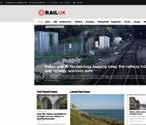










Connecting the UK rail industry for over 26 years.












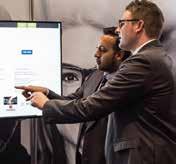












































































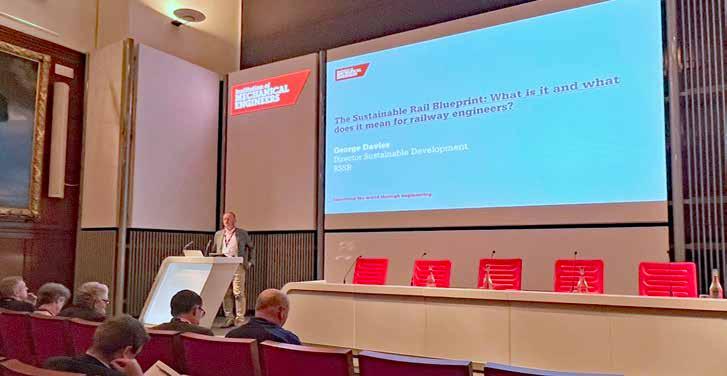
In many ways, Britain’s railways face an uncertain future. One certainty, however, is that with the changing climate railways must adapt to new extreme weather patterns if they are to continue to operate a safe and reliable service.
The recent seminar ‘Adapting Railways for a Sustainable Future’ held by the Railway Division of the Institution of Mechanical Engineers (IMechE) was therefore timely. After considering the overall requirements for sustainability, this event considered railway operations in all seasons, energy and waste reduction, and how electrical traction demand could be smoothed. As we report, this was an interesting event.
The overview was provided by RSSB’s director of sustainable development, George Davies, who outlined the industry’s Sustainable Rail Blueprint (SRB). He advised that the SRB, which was published in November, is now moving to implementation. It has 11 topics which support three sustainability aspects as follows:
» Emissions: Net zero carbon rail; Clean air; A quieter railway.
» Natural Environment: Preparing for a changing climate;
A railway for nature; Zero waste; Protect & conserve water.
» Social Sustainability: Maximising social value; Rail at the heart of communities; Careers, economy, and sustainable growth; People centred rail.
The SRB provides a road map showing how the strategic aim for each topic can be achieved. It also provides six common solutions which are key enablers cutting across the SRB topics. These are: Zero emission traction; Seamless journeys; Nature-based solutions; Social value; Data framework; and a Culture for Sustainability.
Professor John Dora of Climate Sense noted that in the five years up to 2029, the rail industry planned to spend £2.8 billion in climate change adaptation which is the subject of ISO 14090:2019 ‘Adaptation to climate change – principles, requirements and guidelines.’ There is therefore a need for effective management and competence to ensure compliance with this standard. To achieve this, he described an RSSB-funded project to develop a climate change adaptation maturity matrix which can be used to assess adaptive capacity across the UK rail sector and provide organisation-specific action plans.




The next six presentations covered planning and mitigation of different extreme seasonal weather hazards. Brian Haddock, Network Rail (NR)’s head of seasonal and weather resilience, set the scene with a presentation on planning for extreme adverse weather. His presentation described the available meteorological tools, risk-based planning, and how weather action plans are communicated as described in our feature ‘Responding to Scotland’s weather’ in Issue 206 (Jan-Feb 2024).
The importance of railway water management and how this is supported by a catchment analysis was the topic of a presentation by Mona Sihota, NR’s technical head, drainage and lineside. This role was created in 2015 and its importance was tragically highlighted by the Carmont derailment. This led to the development of NR’s Water Management Strategy in collaboration with the Environment Agency. This shows how NR now considers drainage to be a whole system of assets that manage water between it coming onto and leaving NR’s infrastructure. It also requires NR to be a good neighbour that works with adjacent landowners to mitigate flooding onto the railway and avoid flooding adjacent land.

An important aspect of this strategy is its catchment analysis which considers, amongst other things, the peak flow, slope, and land use for 100,000 individual surface catchments to determine the threat they present. Catchment polygons, coloured according to threat, will then be displayed on NR’s GeoRINM viewer to provide a better understanding of flooding risk, and improve the management of drainage assets.




Low adhesion during the autumn leaf season is a well-known hazard covered by many articles in Rail Engineer. One solution, high pressure water abrasive suspension, was described by Tanya Ball of LNT Solutions Ltd. She described how a project to evaluate this system was being sponsored by NR’s performance innovation fund. To do so it had been fitted to a Class 153 unit and tested for two weeks on the heritage East Lancashire Railway.
To test the system, three layers of leaves were applied to a clean rail head at various test sites and then rolled over by a diesel locomotive. This reduced the coefficient of friction from typically 0.16 to 0.04. After one test cleaning pass at 60 mph, it was then found to have increased to 0.14. There are now plans to trial this system in autumn out of Exeter and on the Fife circle in Scotland.
Managing the vegetation that causes this adhesion problem will become more challenging as increasing average temperatures extend the growing season. Vegetation can also cause significant sighting problems and present risk to overhead line electrification equipment. In her presentation, Cordel’s development director, Rebeka Sellick, explained the benefits of Artificial Intelligence (AI) to analyse lineside vegetation growth information captured by train-mounted LiDAR equipment.
She explained why this is a cost-effective approach which can rapidly identify the types of risk presented by vegetation, assess the amount of vegetation to be removed, detect trends, and quickly provide useful information for maintainers on map-based displays.
The summer risk of track buckling was considered by the University of Southampton’s Professor William Powrie. He noted how 2022 saw many locations break their highest temperature record by 3°C with a new UK record at Coningsby of 40.3°C. As rail temperatures can be over 50°C when the air temperature is 37°C, this is a significant problem. Rails are laid with a stress-free temperature (SFT) of 27°C, however this can vary along the track. As UK annual temperatures increase so does the potential for rail buckling. Professor Powrie’s research modelled rail buckling temperatures and the factors that need to be managed to reduce this risk i.e. rail and sleeper type, track irregularities, and ballast condition. It also showed the extent to which reducing train speed reduces buckling risk, though such mitigation should be a last resort.


The London tube is not exposed to the weather and does not have the vegetation issues faced by the main line railway. However, compared with modern metros, it has diminutive tunnels which must dissipate a lot of heat from brakes, motors, and passengers.
In the early days of the tube, the temperature in the tunnels was 14°C which is that of the London clay through which they were bored. Indeed, the way that the tube offered a relief from the hot sun above was promoted in early adverts. However, over more than a hundred years, the temperature of the clay around the tunnels has increased and tube air temperatures can reach an uncomfortable 30°C. This also reduces the efficiency and reliability of trains and equipment. With planned increases in service frequency, tube temperature has become an urgent problem especially as the platform air handling units used to cool stations are prone to blockages due to dust and dirt in the tunnels.

In their presentation, TfL’s Anthony Ridley and Emil Tschepp described the development of more reliable station cooling systems funded by Innovate UK. This changes the orientation of the cooling coil to remove the risk of blockage. After testing a full-size prototype, this was installed above a disused platform at Holborn. This validated the concept and achieved a cooling output of 12kW/metre though it highlighted issues with condensation and water flow rate sensors.
As a result, the design has been developed to use a more efficient aluminium extrusion profile, incorporating a drip guard, to work with axial fans and increase the number of panel layers from two to three. This is expected to increase cooling performance from 12 to 26 kW/m with between four and eight units per platform needed. The intention is to install these cooling systems as part of the Piccadilly line upgrade which will see an increased service frequency with the introduction of its new trains.

emissions standard. Five of these were modified to become Battery Electric Multiple Units (BEMU) by removing the underframe diesel engine and its roof mounted cooler group and fitting batteries with a thermal conditioning unit. Network testing of these units is to start this year.
Richard Thorp, HS1’s director of engineering & technology, presented his company’s strategy to deliver net zero. Currently, HS1’s annual energy consumption is 213GWh of electricity and 8GWh of gas which results in direct emissions of 46,400 tonnes CO2E per annum. He noted that these emissions were much less than the 750,000 tonnes CO2E per annum that could be saved by modal shift from flights and cars onto HS1.
HS1’s plans to eliminate both direct (Scope 1) and indirect (Scope 2) emissions include procuring net-zero electricity via a private wire and the replacement of boilers with heat pumps at St Pancras, Stratford, and Ebbsfleet. Richard considered that these plans were robust though he advised that a strategy to reduce Scope 3 emissions from HS1’s supply chain had yet to be developed.
He concluded by pointing out that effective carbon reduction plans require a balanced portfolio of large and small schemes and that energy reduction schemes come with a positive business case.
Finding the right solution to decarbonise rail vehicles was the subject of a presentation by Ian Robinson, Alstom’s platform engineering manager. Ian pointed out the benefits of modifying existing fleets with sufficient residual life as this required less embodied carbon. However, he also highlighted the challenges of such modifications in respect of space and weight constraints as well as systems integration with existing equipment and train control systems.
He described two case studies. The first was the SNCF AGC fleet which are diesel electric multiple units that operate on electrified and short unelectrified sections and have engines that do not meet the latest
The other case study concerned an Australian VLocity diesel multiple unit (DMU) that also had an engine that did not meet latest emission standards and for which there was a target to reduce fuel consumption and emissions by 25%. With no electrification in Australia, the solution was an engine and transmission upgrade and intelligent engine management.
Colin Musisi, a development engineer with Porterbrook Leasing described how rolling stock could be modified to make it more resilient to climate change and more comfortable for passengers. Such modifications were necessary as those who wrote standards before 2000 did not foresee rapid climate change. Porterbrook is currently reviewing rolling stock standards to identify aspects that need to take account of the changing climate.
One consequence of this is that trains do not always keep passengers comfortable. For example, due to higher temperatures the specification of heating, ventilation, and air conditioning (HVAC) systems require them to operate almost continuously which makes them more prone to failure. As a result, Porterbrook is trialling variable HVAC temperature set points to maintain the coach air temperature relative to that of the outside air temperature, rather than at an absolute value. Research indicates that, on hot days, passengers want a coach that is noticeably cooler than the outside air rather than an absolute temperature setting.
Another Porterbrook trial is the application of thermal window film which has been shown to offer a slight reduction to coach temperature. Colin advised that the preliminary design for the LNER tri-mode units that have recently been ordered from CAF incorporates solar reflective windows and HVAC systems with variable temperature set points.



With parts of the OLE feeder system already running at their full capacity during peak demand, managing traction power demand is becoming increasingly important.
Furthermore, the demand for electrical power will increase as more electric, battery, and bi-mode trains are introduced. Accurately predicting this demand in real time to make smarter use of the available traction power supply is the aim of RSSB research report T1270.
The authors of this report, RSSB’s principal energy engineer, Chibuzor Edordu and Navitas Engineering’s principal design engineer, David Allchin explained the findings of this research.
This work showed that assessing the power system capacity was not straightforward as it is subject to various constraints which include voltage harmonic and unbalance limits, grid transformer thermal limit and system and pantograph voltage limits with the key constraint being conductor, and cable currents adjusted for ambient temperature.
The T1270 report considered how the power demand from existing and proposed services could be predicted and regulated either by taking operational decisions to limit demand or by real-time controls. Such controls include connected driver advisory systems, direct control of the train traction control management system, and the use of intelligent substation electronic controls as specified in the international standard IEC 61850.
This presentation showed how the T1270 research project work can usefully support the management of OLE feeder systems that are running at capacity. However, it was not clear how it could support long term strategic planning, given the uncertainty of future rolling stock procurement and lead time to upgrade power supplies. What is evident is that if trains are no longer to be powered by diesel, an equivalent amount of additional electrical traction power is required.
The use of high-speed flywheels to recover energy and support rapid traction battery charging was described by Professor Keith Pullen, Levistor’s chief technology officer. Whilst Keith accepted that flywheels are more expensive than batteries, they offer various advantages which include lower embodied carbon, a +20 year lifetime and their power absorption matches that of train braking and acceleration. He considered that flywheels were more costeffective for applications with a high number of daily charge/discharge cycles due to the cost of cell replacement and need to oversize batteries for peak demand.
The cost of fitting flywheels is also justified by potential fuel savings. An RSSB project simulating flywheel fitment on two-car Class 156 operating between Norwich and Sheringham concluded

that they offered 43% fuel savings. Keith also explained the failsafe modular design of the Levistor flywheel which only requires light containment. This is because the flywheel is laminated and should a single laminate fail, the resultant unbalance will stop the flywheel.
Andrew Barr, Hitachi’s president for Europe, Middle East and Africa, gave an informative presentation on the need for holistic battery management. With alternatives to fossil fuels needed to meet carbon reduction commitments and around 40% European rail lines not electrified, he saw a significant requirement for battery powered trains which could be either new or retrofitted trains.
As an example of a new train, Andrew mentioned the Trenitalia Blue train which is an example of Hitachi’s Masaccio platform. This is Europe’s first tri-mode train powered by battery, diesel, or electric traction with the battery recharged enroute. This offers a 50% carbon emission compared with diesel trains.


Retrofitting the world’s largest rail vehicle battery to Transpennine Class 802/2 units is an example of what can be done with existing rolling stock. This retrofitting involved the removal of the motor car’s generator unit, fuel tank, and exhaust and the addition of a box for a 700kWh battery, roof mounted cooling system, and battery protection. This battery vehicle is now under trial to inform the business case for a 100%-batteryelectric intercity train that can run up to 100km in battery mode. Potentially 1,000 generator sets on Class 8xx units could be replaced by this battery which has been developed using automotive battery technology.
Andy advised that the expected life of rail and road vehicle batteries is eight to 10 years, after which they can be re-purposed, recycled, or scrapped. He advised that a huge wave of endof-life batteries is expected after 2030 for which it is critical to have the right facilities, markets, and regulations. He considered that there was a significant demand for second life batteries, for example data centre backups and static battery energy storage systems for back-up power and peak shaving.

To discourage scrap and landfill, he considered that it was important to have battery passports to manage the cradle to grave lifecycle which would, for example, promote innovative recycling to increase raw material recovery. Andrew also felt that there is a need for alternative models of battery ownership, incentivising good battery management through residual values. He noted that First Group has formed a joint venture with Hitachi to purchase up to 1,000 electric bus batteries to make best use of their second life.
Andrew concluded his presentation by emphasising that although batteries are now a credible rail traction option, they need to be supported by innovative commercial solutions.
The many topics addressed by the presentations at this IMechE seminar demonstrated that sustainability has many aspects. In essence, these covered the need to adapt to extreme weather and rail decarbonisation. Yet, as the industry’s Sustainable Rail Blueprint shows, there are even more aspects to sustainability which is a big topic.
The issues addressed by this event showed that much useful work has already been done to enable rail to continue to both operate a safe, reliable, and comfortable service in extreme weather and eliminate diesel passenger traction. However, much more remains to be done. Much of this is for the industry to action, though rail decarbonisation requires Government to commit to a strategic whole-system plan. Yet this requires the Treasury to be convinced that the rail industry can deliver much-needed electrification and power supply upgrades in a financially sustainable manner.
By running this seminar, the IMechE’s Railway Division has performed a valuable service by showing what needs to be done.



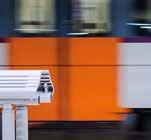































































































In the connected world we all live in, Wi-Fi has become one of the main technologies for wireless short haul and indoor communications. However, a Wi-Fi wireless protocol that is yet to receive widescale adoption is Wi-Fi HaLow (pronounced halo). This uses 900MHz Radio Frequency (RF) bands to provide longer range, compared to the conventional Wi-Fi networks operating in the GHz frequency bands. It also has low energy consumption and can support higher data rates and wider coverage than other radio protocols.


Conventional Wi-Fi provides very good data transfer rates (Mbps), but operating at RF bands of 2.4GHz, 5GHz, or 6GHz, Wi-Fi can suffer from poor propagation and interference from other devices. LoRa (Long Range) technology is capable of communications over several kilometres, but has a limited data packet size and a low data rate (kbps). Wi-Fi HaLow can provide Mbps data rates and over distances of several kilometres.
Another advantage of Wi-Fi Halow for rail is that the GSM-R system also uses frequency channels around the 900MHz band, so the lineside GSM-R mast sites could also possibly support Wi-Fi HaLow for trackside data communications.
Wi-Fi HaLow is designed to meet the requirements of smart devices because of its ability to operate using very low power, penetrate through walls, and operate at significantly longer ranges than conventional Wi-Fi. It should enable applications from small, battery-operated devices to large-scale deployments. The Morse Micro team says Wi-Fi HaLow chip’s power requirement could be under 0.25mW. This would provide a battery lifetime of one month from a CR2032 coin cell or years from two AA batteries, and the charging for rechargeable batteries could probably be sourced from solar power.

In radio, higher radio frequencies systems cannot communicate over longer distances when compared to lower frequency systems. So 900MHz Wi-Fi HaLow can communicate over longer distances than conventional Wi-Fi which uses GHz frequencies, and it can propagate more easily through walls and reach devices that reside further away (at least double the range of 2.4GHz Wi-Fi and even more than 5/6GHz Wi-Fi), all while requiring significantly less power. In January, The Morse Micro team (which includes the original inventors of Wi-Fi and designers of Wi-Fi chips) staged a record-setting field test of a long-range video call over 3km.
The Wi-Fi Alliance (which sets the Standards for WiFi) ratified Wi-Fi HaLow in 2017 as 802.11ah, based on the 802.11 2007 wireless networking Standard. It has a theoretical data rate of up to 86.7Mbps and can operate with 1, 2, 4, 8, and 16MHz channels. It also uses modulation and coding schemes that can accommodate different RF conditions and distances between devices, including the use of repeaters. According to the Wi-Fi Alliance, Wi-Fi HaLow is an open standard which can co-exist with Wi-Fi 4, Wi-Fi 5, Wi-Fi 6/6E, and Wi-Fi 7 networks without suffering RF interference. It also supports IP and complies with the WPA3 wireless security encryption algorithm. Power-saving features include Target Wake Time (TWT) and Restricted Access Window (RAW), to reduce channel contention and minimise power consumption, by ‘sleeping’ for long periods of time or in between predictable activity patterns.


Despite the advantages of Wi-Fi HaLow, adoption has so far been slow. It would appear that there are only so many Wi-Fi chip designers in the world and a lot of effort has gone into Wi-Fi 6 and Wi-Fi 7. The big companies need to target their resources where they make their best revenues, and while producing around 4 billion Wi-Fi chips annually, they cannot yet focus their resources on producing another RF Wi-Fi chip. This may change though.
The availability of sub-GHz spectrum for Wi-Fi HaLow also varies around the world. There’s a lot of spectrum available in the US but not in Europe. A particular problem for the UK is that Ofcom has already allocated 900MHz band licences to Mobile Network Operators (MNOs), which currently leaves very little unlicensed spectrum for Wi-Fi HaLow. This limits the spectrum for HaLow and data speeds are said to start at around 150kbps, rising to a few Mbps. Ofcom has been known to take back spectrum from MNOs, but would the MNOs provide a Wi-Fi HaLow service using their licenced spectrum? This is unlikely, but we will have to see what develops.
When it is available, Wi-Fi HaLow is predicted to be more robust and reliable than normal Wi-Fi and it should work well in dense environments. This could be an entire station, office, or warehouse. With Wi-Fi HaLow in outdoor environments, multiple kilometre ranges with Mbps data throughput should be possible, making it ideal for rail.
The Wireless Broadband Alliance (WBA) announced in January that its Wi-Fi HaLow for IoT programme has moved into a new phase and this year it will showcase its Wi-Fi HaLow solutions in real-world use cases. These include applications including Smart Home, Smart City, Smart Building
Automation, Smart Retail, Industrial IoT and Agriculture Technology.
In the coming months, the project team will test the use cases and applications to demonstrate the benefits and performance of Wi-Fi HaLow, including understanding coverage areas, data rates, throughput, and signal reliability. The analysis from the trials will inform new deployments and help the wider industry to roll-out IoT solutions. The trials will include:
Smart Home – Evaluating Wi-Fi HaLow against traditional WiFi security cameras, Heating, Ventilation, and Air Conditioning (HVAC) appliances, detached garage connections, solar power systems, power backup generators, and electric vehicle chargers.
Smart City – Focusing on infrastructure monitoring, smart utilities and traffic management, high data throughput, increased device density and low-cost maintenance.
Smart Building Automation – Conduct testing to support smart building applications such as physical security, surveillance, access control, safety alarms, and water sensors.
Smart Retail – To showcase how Wi-Fi HaLow could enhance consumer satisfaction and increases productivity for retailers.
The assessment will cover scanners, readers, point-of-sale equipment, asset tracking, security monitoring, warehouse robots, and handlers. Industrial IoT – A focus on testing industrial applications including asset tracking, infrastructure monitoring, remote equipment control, safety automation, and security monitoring. This will benefit the rail industry. Agriculture Technology – Trials in smart agriculture or precision farming systems, including environmental monitoring, soil monitoring, plant health monitoring, actuator control, and data collection for predictive breeding.
It’s likely that Wi-Fi HaLow will gain adoption in the coming years. Already there are outdoor security battery-powered AI-enabled smart cameras capable of working over distances of several km being developed, and other rail applications could include CIS and PA systems and Internet of Things (IoT) sensors for all types of assets. Wi-Fi HaLow is unlikely to replace conventional Wi-Fi devices, but it should create new applications with designers being able to put devices and sensors in places, and with data throughputs not possible today.





Innovation continues to be one of the rail industry’s buzz words but can be used in many contexts. Some of these may be a plea for new thinking to solve a particular problem; a product or service that could improve a traditional system or work method; blue sky thinking that might revolutionise how the railway is operated; or a means of promoting companies who engage in creating ideas.
All of these ideas come together at some point but require an occasional forum to enable them to be put in front of potential clients and encourage collaboration between organisations who might have similar concepts to avoid the possibility of inventing the same thing twice.
The Railway Industry Association (RIA) has a track record of organising events that promote new thinking and is currently hosting four seminars around the UK with a common theme while recognising some regional differences in terms of need. A national conference held in Newport, South Wales, was reported on comprehensively by David Shirres in Issue 208 (May-June). This is being followed up by more regional events and Rail Engineer attended the recent London event, which focussed on some of the challenges relating to the South and South East areas. Others have or will take place in York, Manchester, and Glasgow.
The London event attracted a surprising number of both industry organisations and potential customers. Industry included companies large and small ranging from multi-national giants to small and medium enterprises (SMEs). A number of 15-minute presentations were given to both describe some of the present challenges and also to consider how some of these might be solved.
Following this, each company was given a fiveminute ‘spotlight’ to present themselves and their various offerings. Capturing all that was on offer became something of a challenge with stands spread over three floors. Some common themes emerged with condition monitoring of assets both infrastructure and trains, and the associated challenges of collecting data and intelligent analysis of the data being promoted by several companies. Recognising climate change and how it impacts rail assets was another hot topic. Some of the challenges were obvious but others were things that no-one really gives any thought to. Here are the topics from some of the organisations:


Network Rail. As the national rail infrastructure owner, with the challenge of keeping it in good order, one would expect a significant wish list for new ideas into the future. Robert Frith, the head of engineering for the Southern Region, explained the changes that rail travel has brought to communities over the years with the most recent being HS1 and how some people live in France and commute to work in England.
Network Rail wants happy customers and stakeholders, a safe and secure railway that is both affordable and profitable. An integrated delivery team of civil, signal & telecom, track, electrification & plant and minor works, all using common technologies, systems and methods, is the future ambition. Companies that can offer the tools to achieve this will be more than welcome.
Transport for London. Thomas Ableman, the director for strategy & innovation is looking and listening for challenges across all modes of transport which includes cyclists, bus optimisation, and the ever present demand for accessibility. Four main areas need attention:
» The platform / train interface where over 1,000 incidents occur every year with a fatality every five years. The need for ‘smarter’ stations and the upgrading of CCTV monitoring are part of this.
» Tube noise. New buildings are going increasingly deeper into the ground resulting in many complaints of intrusive noise from tube train movements. How to make the Underground quieter needs to be looked at.
» Tube dust. Air quality is not improving underground and it needs attention. Too
much braking with conventional brake technology is the main problem.
» Asset theft and vandalism. Security of equipment to ensure correct functioning is an increasing requirement and has safety connotations. How to prevent unauthorised access is both a technical and social challenge.
TfL has an online portal for people to put forward ideas. Many of these will be rejected but it’s still worth doing as a small number will be taken forward or will lead to the generation of other ideas.
South Western Railway. Train Operating Companies (TOCs) are more in the spotlight for customer interfaces than other rail organisations. Dan Piner, design and innovation manager for SWR, quoted statistics for TOC performance with South Western achieving 84%, which is midrange. Seven themes have been identified to improve this score.
» Punctuality.
» Seat comfort.
» On board environment.
» WiFi performance.
» Guard visibility and passenger interaction.
» Information provision during disruption.
» Station environment.
Add to these, safety, sustainability, accessibility, and inclusivity, you have quite a shopping list. Some of these are already being acted on: guard visibility is being investigated by the Gamification project in conjunction with Chrome Angel; improved customer information using QR codes on seat backs is being trialled on Classes 158, 159, and 444 trains that, when scanned, will yield real time running data; on board occupancy software known as project Glimpse has several suppliers involved. Super-fast WiFi on the route from Basingstoke to Earlsfield (near Wimbledon) is installed to test customer reaction. This is known as EvoRail.
There is also TOC Innovation Community and between seven to 12 TOCs are involved depending on the particular interest. University involvement and UKRRIN. Many UK universities are engaged with industry in rail systems research under the banner of the UK Rail Research and Innovation Network (UKRRIN). Rod Anderson from the University of Southampton spoke about its geomechanics lab which is investigating the impact of climate change, autonomous systems, and laboratory testing of structures.


The co-operation between 20 universities and 25 industry partners is led by University of Birmingham with funding of £28 million being received from government and £61 million from industry. Specialisation is allocated around the country with Birmingham focussing on digital systems and automation, Huddersfield on rolling stock, Loughborough doing track adhesion, Newcastle investigating pantograph monitoring, and Southampton majoring on infrastructure including field work. Product testing of sleeper materials and bridge beams are examples of the work being undertaken by the latter.
Some of the more seemingly day-to-day situations that cause aggravation and distress were described by Dave Looney, head of product strategy at Telent. Trespass, vandalism, graffiti, and abandoned luggage are all things that can cause disruption to services and huge cost to the industry. Finding ways to combat these menaces is ripe for innovation.
The Telent system Management Integration and Control of Assets (MICA) system has been in being for some time, but its use and facilities have expanded in recent years. Bicycle thefts at Reading are a particular example, where, following a study to analyse the conditions, improved CCTV and fence security has significantly improved the problem. Using Artificial Intelligence (AI) to unlock the value of data together with automation of received data and images is part of the MICA package. Even the challenge of the Dawlish sea wall is benefitting from a LIDAR application to give early warning to drivers.
The Rail Safety & Standards Board (RSSB) was set up in 2003 following the Ladbroke Grove accident, to be an independent promoter of good safety practice and to establish and be custodian of national rail standards. Aaron Barrett, lead research analyst, told of RSSB’s involvement in the setting of rail technical strategy in terms of research and practical implementation, commensurate with changes to rail usage due to macro changes in society and rail funding within the control periods. There is a focus on major technical problems and opportunities, but the functional priorities are: making rail easy to use for everyone; being freight friendly; lowering emissions; optimisation of train operations; and having efficient and reliable assets. Using freight friendly as an example, innovation is required to:
» Increase network access, given the history of a mixed network railway.
» Shorten journey times by optimising passenger and freight movements.
» Increase modularity and ease of transfer from/to road transport.
» Improve freight train safety.
» Lower carbon emissions by reducing diesel usage under the wires.
» Track design that can support higher axle loads.
» Reduce gauge restrictions to maximise routes.
» Use digitised systems to understand availability and suitability of diversionary routes should a planned route become unavailable.
» Understand the cost of these requirements for both investment and maintenance.


With a general election looming at the time of the event, Jez Smith from the Rail Delivery Group asked what is the likely prediction for rail? There has been all party support for an integrated rail body such as Great British Railways (GBR) and Labour’s intention to nationalise the remaining TOC contracts has been well publicised, although it is not expected to have any great impact on finance. However, it seems there will be no more money for rail, meaning the industry needs to do more for less, which is where the innovation bit comes in.
Data is the biggest untapped resource for rail. Other industries have harvested this more efficiently with better operational decision making, understanding of customer behaviour, and improvement of the journey experience. Innovation is required to: (i) use data instead of human intuition; (ii) be clearer on who owns data and be prepared to share it; (iii) recognise who the competitors are (the car and the lorry); and (iv) be prepared to ask for data if you think you need it. There is a Rail Data Market Place with 104 products already visible and available, with more to come.
Creating novel ideas is relatively easy, whether modest improvements to existing practice or completely new methods for operating or engineering the railway. Turning these ideas into a practical implementation is much more difficult. First, the idea has to be seen to add value by the intended customer or recipient. A trial operation needs to be carried out at a low-risk site (often a heritage railway) to assess day to day usage benefits and constraints. Often an approval process will need
to be applied for and progressed, which can take months or even years. Finally, the product may have to be manufactured on a commercial basis ensuring that a profitable outcome can be obtained. It can take years to maximise the full benefit, a good example being Train Protection & Warning System (TPWS) where invention, testing, approving, and deployment took well over a decade. There is rarely a quick fix and companies need to be aware of this. This is not to say that innovation should not happen. It is new ideas, methodology, and ways of working that will take the industry forward but please do this with your eyes fully open. Overall, an intriguing event day with lots of ideas being promoted. We will watch how some of these turn into reality.

Here are some of the ‘Spotlights’ from the various organisations present, not in any particular order or significance:
» Telent. In addition to MICA, the Acumen asset monitoring system is used for all kinds of alert or alarm warnings in real time. Aimed primarily at building security and safety e.g., lift operation.

» Gripple. A leading UK manufacturer of wire joining and tensioning solutions. With a commitment to innovation, sustainability and quality. Their new game-changing SwiftLine Rail Dropper / SwiftLine Rail Jumper Clamp have been developed in close collaboration with rail industry OLE experts to allow contractors to install faster, work safer, and deliver more in every possession window. Thanks to the innovative designs, including the tool free Auto-Torque Contact Clamp, fixings engineers can install right first time with confidence. Gripple rail solutions are simple, reliable and Network Rail product approved.
» Sensonic. Landslide and rock fall monitoring using fibre optic sensing.
» Tended. An ‘electronic fence’ to alert trackside workers who stray out of a safety zone that they are in potential danger. Achieved by persons using a wearable device that alarms if the ‘fence’ is crossed.
» Omnicom (part of Balfour Beatty group). Rail data collection from mobile cameras that measure and monitor collected images, checking these against previous pictures for changes to infrastructure using intelligent data analysis.
» Sicut. Design and manufacture of rail sleepers using re-cycled plastic material. Avoids deforestation of hardwood and is suitable for plain line and bearers for points and crossings.
» Staytite. Improved fittings for PWay using the Hardlock Nut for fishplate fixings.
» Jurnyon. Smart ticket using AI for self-validation.
» Softech Rail. International company doing S&T and OLE design work including installation and testing of IP/MPLS data networks.
» Findlay Irvine. Monitoring of adverse weather conditions with predictions for wind and snowstorms and potential damage impact. Also track temperature measurements in hot weather.
» Helix Rail. Project management using digital tools for material supply and control by data capture of quality checks, shift reports and site surveys including video capture and photos.
» LB Foster. Friction management expertise to reduce train noise and component wear.
» Onwave. Geofencing systems and control logistics for improved site safety of workers.
» Jnction. Decision support tools using AI for improved information to travellers when delay and disruption occurs with output to information systems, social media and frontline staff.
» Complete Cyber. Expertise to provide security architecture patterns for both rolling stock and infrastructure including aftercare and staff training.
» Plowman Craven. Infrastructure monitoring using drones. Typical periodicity of three months to distinguish changes without requiring physical access or a possession.
» Geoptic. Uses muon tomography (a type of X-Ray imaging) that exploits naturally occurring radiation to survey inaccessible objects such as tunnel shafts which may have been sealed off.
» Siemens. Provision of Connected Driver Advisory System (C-DAS) information with display shown on the GSM-R cab radio screens.
» Cordel. Lineside monitoring using video recognition and inertial navigation positioning of infrastructure with typical periodicity of six weeks. Used on the Network Rail national gauging train or as a low power portable unit on other trains. Measurement of vegetation growth and OLE regulation a speciality with customer portal access.
» KONUX. Monitoring and planning of rail infrastructure management including predictive maintenance, network usage, and traffic planning, using AI techniques.
» Tire Conversion. Design, engineering and manufacture of products using recycled tyre rubber crumb.
» Integrated Human Factors (IHF). Digital monitoring of people fatigue factors aligned to improved safety of the workforce undertaking infrastructure and depot work.
» FirstClass Safety & Control. Depot safety techniques linked to depot points and signals layout with automatic alerts when train movements are taking place.
» MERMEC. Optoelectronic real time measurement of track geometry and other rail infrastructure.
» Kokpits. Improving efficiency of road transport drivers waiting or dropping people at stations to reduce passenger wait time, congestion and emissions.
» Centre for Modelling and Simulation (CFMS). Autonomous robotics to design, implement, and monitor major project work for maximising efficiency. An example includes HS2 civil works and optimisation of the mass haul of excavated material.
» Ambient Vision. Intelligent CCTV and image processing to detect unauthorised persons at the lineside and thus combat trespass, vandalism and theft.
» RailScape. Drone surveillance of rail infrastructure and stations for vegetation control, fencing, and environmental services.
» One Big Circle. Automated Intelligent Video Review (AIVR) product using forward facing video for track and OLE scanning with data intelligence to locate, measure, and analyse images for planning, sighting, and reporting activities.
All of these represent considerable ingenuity and free thinking. There are repetitive themes, particularly in the need for better monitoring of infrastructure for natural occurrences and unwanted intrusion, so some combining of effort to establish best practice might be called for.




